As I’ve said in the previous sequel of my stories about the travels along the French Riviera in 2022, with the surface area of a little over 2 sq. km, Monaco is the second smallest country in the world. Only Vatican is smaller. Although Monaco and Monte Carlo are often used as synonyms, Monte Carlo is in fact only one of the wards of Monaco.
I arrived in Monaco by train and then went down on foot to the flat part between two hills that belongs to La Condamine ward. From there, following a wide path, I started to climb to the top of the ward of Monaco City (Monaco-Ville) which incorporates the oldest parts of the principality.
Soon I reached one of the gates and this one concretely was built in 1714.
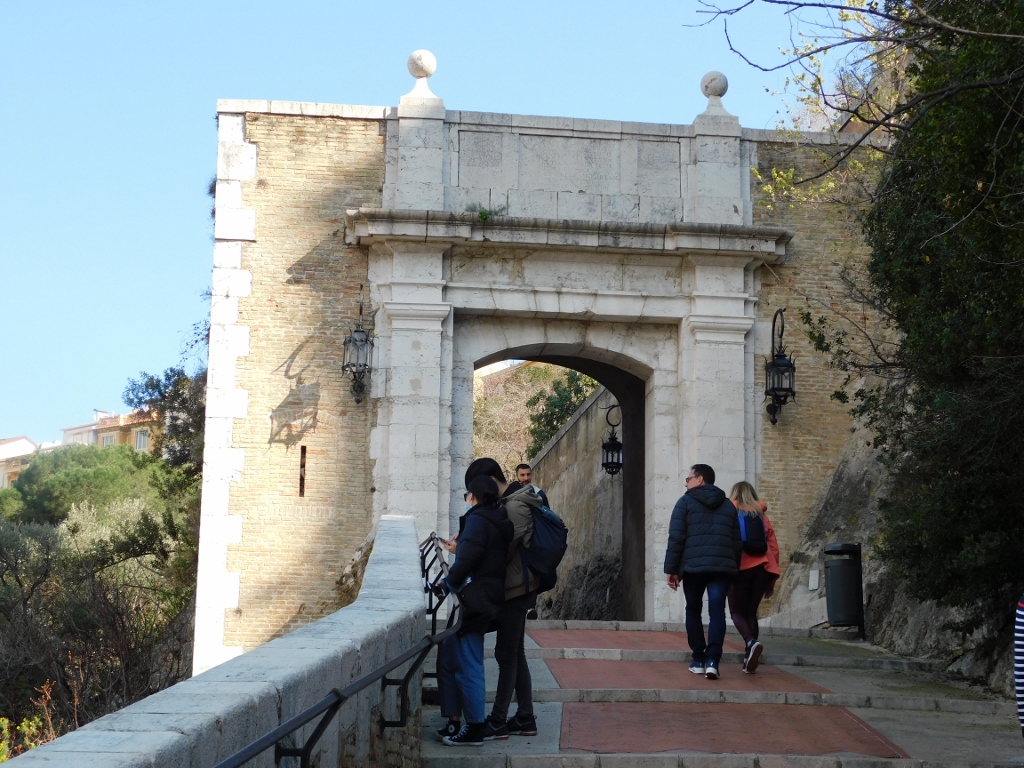 One of the gates on the way to the top of Monaco-Ville or Monaco City
One of the gates on the way to the top of Monaco-Ville or Monaco City
When I passed through the gate, I made a break in order to take photos of Monaco, as there is a very nice view at the principality from here.
 View at Monaco
View at Monaco
The path zigzags uphill and soon I reached another gate. This one was built in 1533.
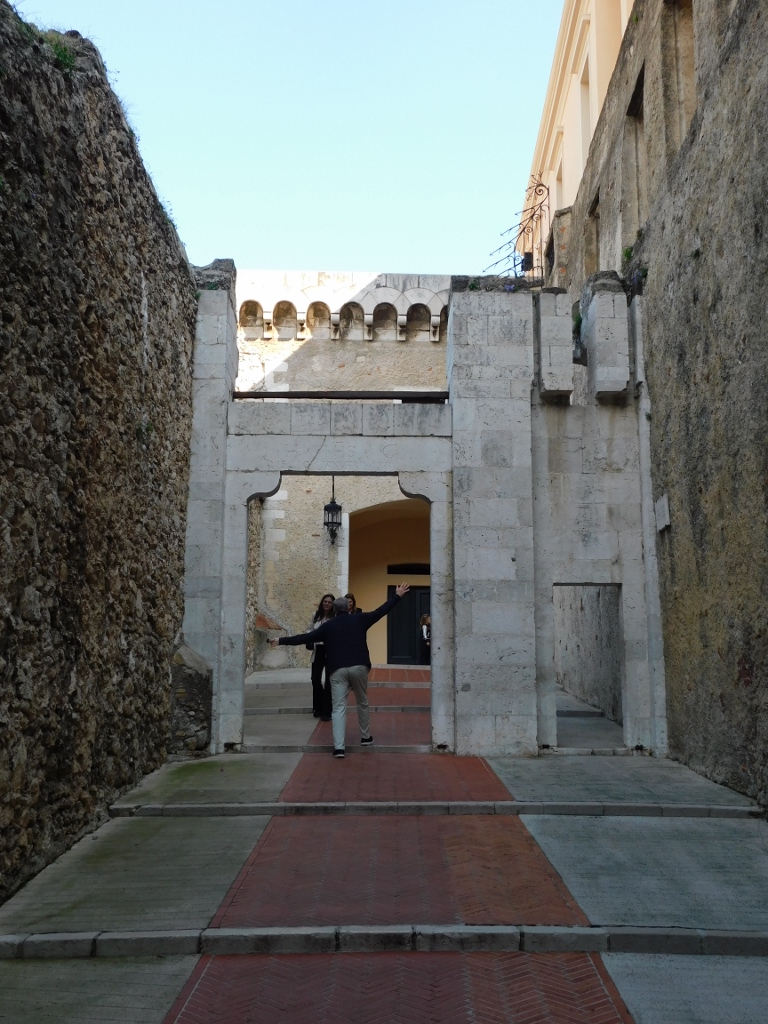 The 1533 gate
The 1533 gate
Once you walk past this gate, on the top of the wide path, you turn to the right and go through a smaller tunnel which practically takes you to the Palace Square (Place du Palais).
 Palace Square: the palace is to the right
Palace Square: the palace is to the right
For the time being I did not deal much with the square, apart from taking a photo of François Grimaldi Statue placed at the very beginning of the square, right at the top of the staircase that leads here.
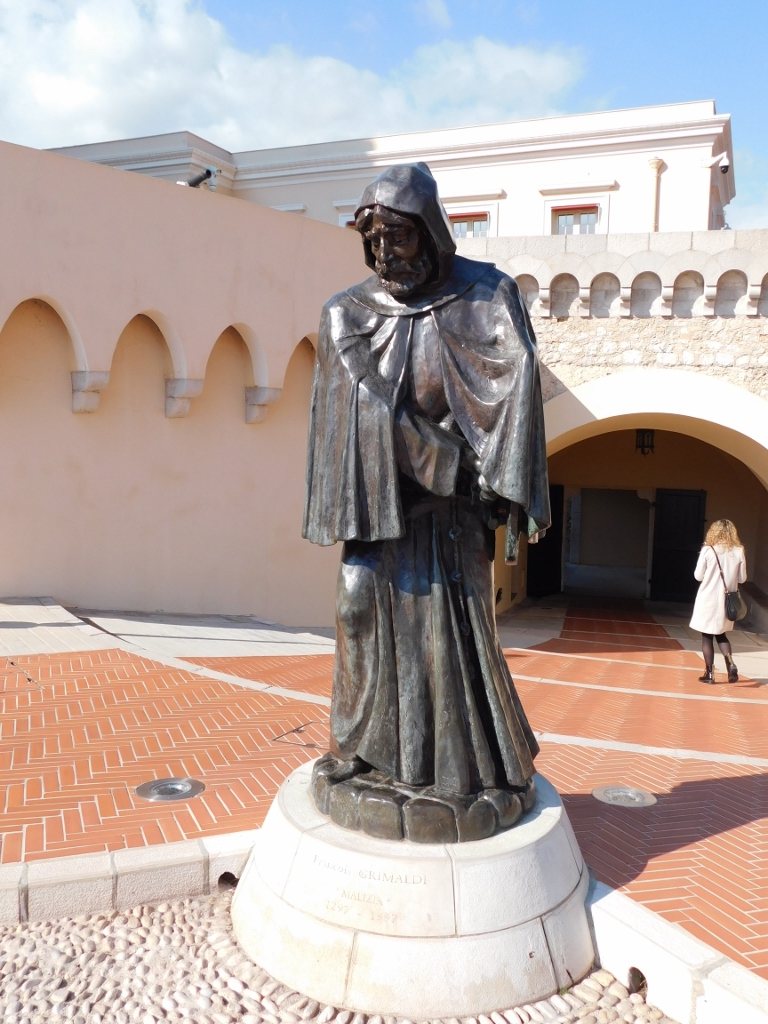 François Grimaldi Statue; behind it there is the tunnel through which the visitors must go in order to get to the square
François Grimaldi Statue; behind it there is the tunnel through which the visitors must go in order to get to the square
François Grimaldi (and it would be more correct to call him Francesco, since he came from Genoa, Italy) was the first Grimaldi who tricked his way into Monaco’s castle in 1297 by dressing up as a Franciscan friar. Once inside the castle, he opened the gate for his followers. Still, the Grimaldi dynasty that is ruling Monaco does not originate from François (who was indeed the first Grimaldi who tried to rule Monaco), but from his stepson – Rainier I of Monaco. And yet, the Grimaldis became the rulers of Monaco only in 1419, by purchasing it from the Crown of Aragon.
But, instead of dealing with the square, I first went to a terrace-viewpoint.
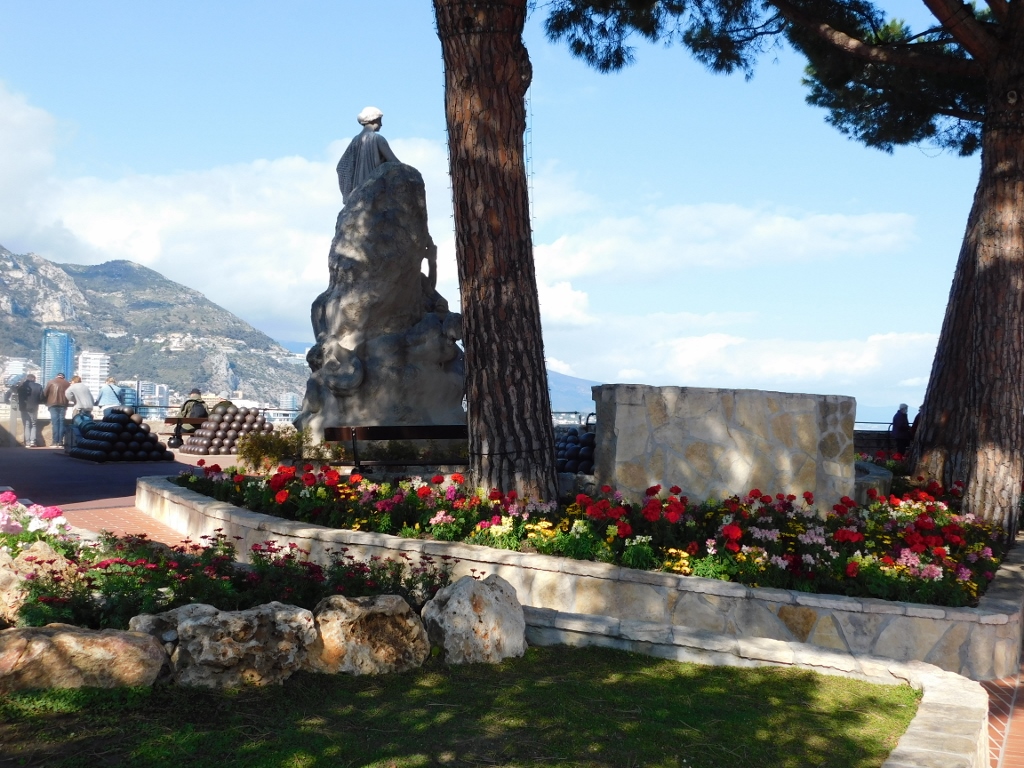 Smallish park and the terrace-viewpoint by the Palace Square
Smallish park and the terrace-viewpoint by the Palace Square
 View at Monaco from the Palace Square
View at Monaco from the Palace Square
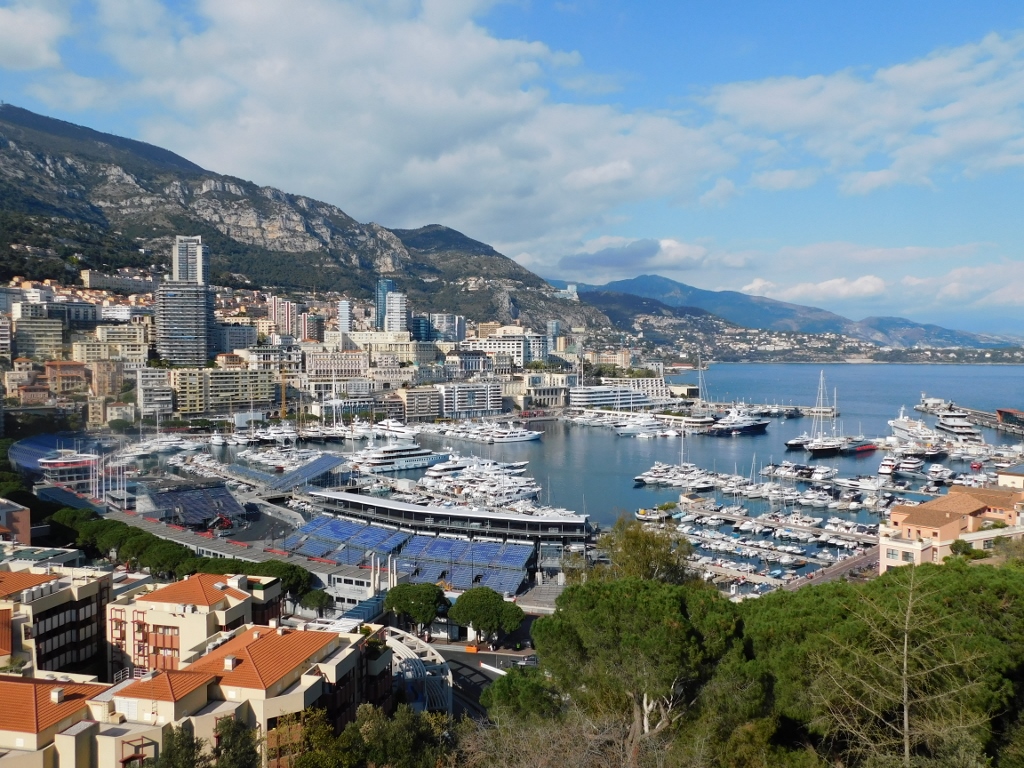 View at the port in Monaco (note the blue stands by the port)
View at the port in Monaco (note the blue stands by the port)
Then I walked a little along the path beside the wall and at some point I made a panoramic photo using my mobile phone.
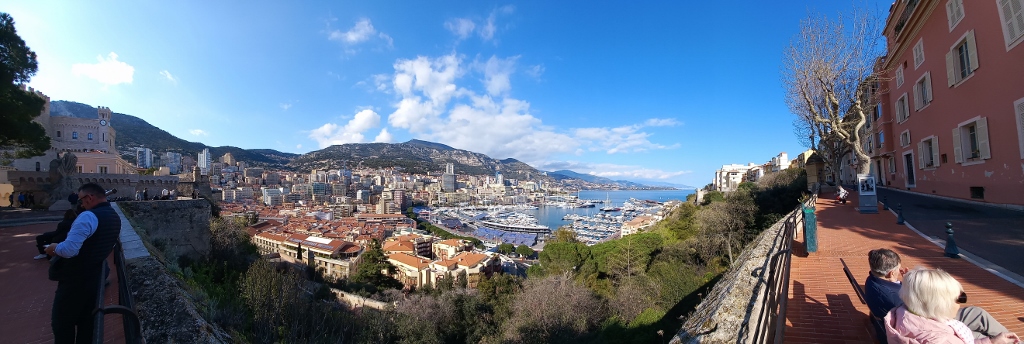 View at Monaco
View at Monaco
Then I returned to the Palace Square where I walked a little, looking around and taking photos.
 Palace Square
Palace Square
The Prince’s Palace of Monaco is the official residence of the ruler of Monaco which is currently Prince Albert II of Monaco. The original palace was built here in 1215, as a fortress of the then Republic of Genoa, but naturally over time it has been demolished and restored and expanded. Nowadays, a part of this palace may be visited as a museum.
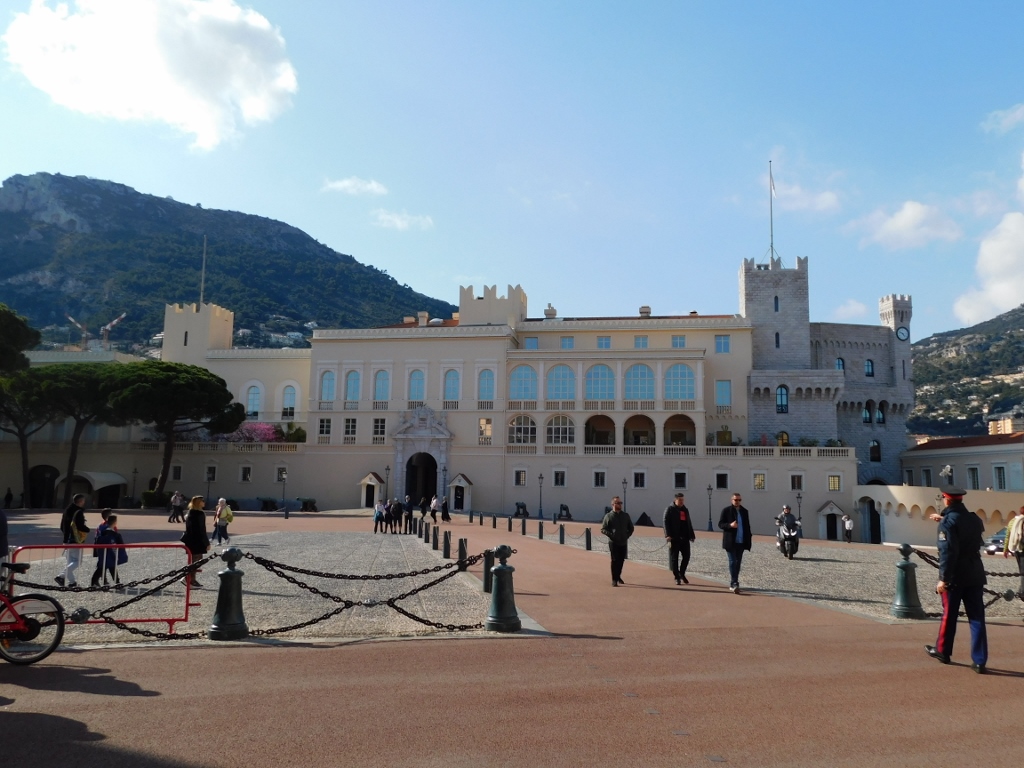 Prince’s Palace of Monaco
Prince’s Palace of Monaco
I did not visit this museum either, but first I just roamed around the square and then I continued with my walk around Monaco City.
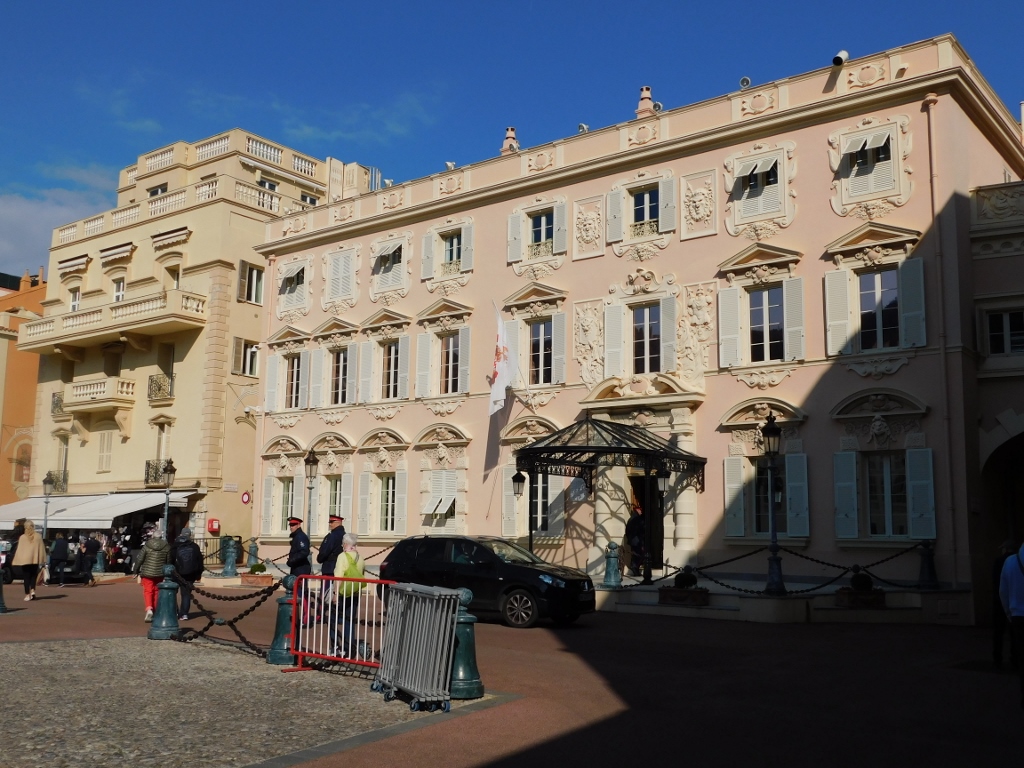 Palace Square, a detail
Palace Square, a detail
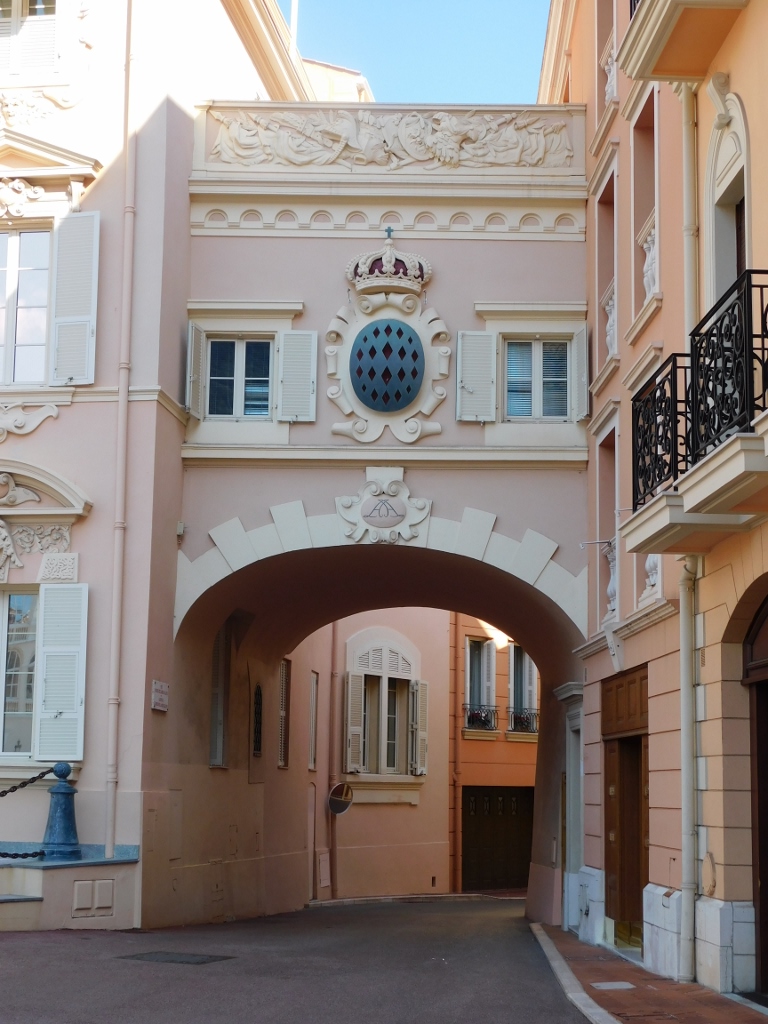 Palace Square, a detail
Palace Square, a detail
Everything was, so to speak, like a box of chocolates here – sweet and in its right place. No wonder. Monaco is considered the least poor country in the world. This is logical, since on the other end of the scale it has the highest GDP rate per capita, as well as the highest number of millionaires and billionaires per capita. One of the main sources of income for the principality are casinos, but what mostly attracts the new-comers or “immigrants” (I like to use this term for this category of people) is the fact that the principality does not collect tax and thus rich people love to come here in order to keep more of the money that they have earned one way or another.
Back in the day I met an Italian on the Seychelles (!) who was there to buy a hotel and who had a permanent residence in Monaco! (This sounds like a great story to tell friends over coffee or to grandchildren in lieu of WWI stories.) Anyway, he told me then that the residence permit in Monaco may be obtained only by autochthonous residents, and there are very few of those, and by people who have a certain (very high) level of income. In other words, the poor may come here only to walk around, do the sightseeing and leave whatever money they have, or to serve those who have more money, but not to live here. Well, that’s fine. That is also a part of life. So, I just walked around. I did not even leave a lot of money there. The residents of Monaco and I are not in the same category of people, since, after all, I choose who I mingle with and money plays absolutely no part among my friends.
In the continuation of my walk across the top of The Rock, as this part of Monaco is called informally, I also reached the Palace of Justice that has very interesting architecture.
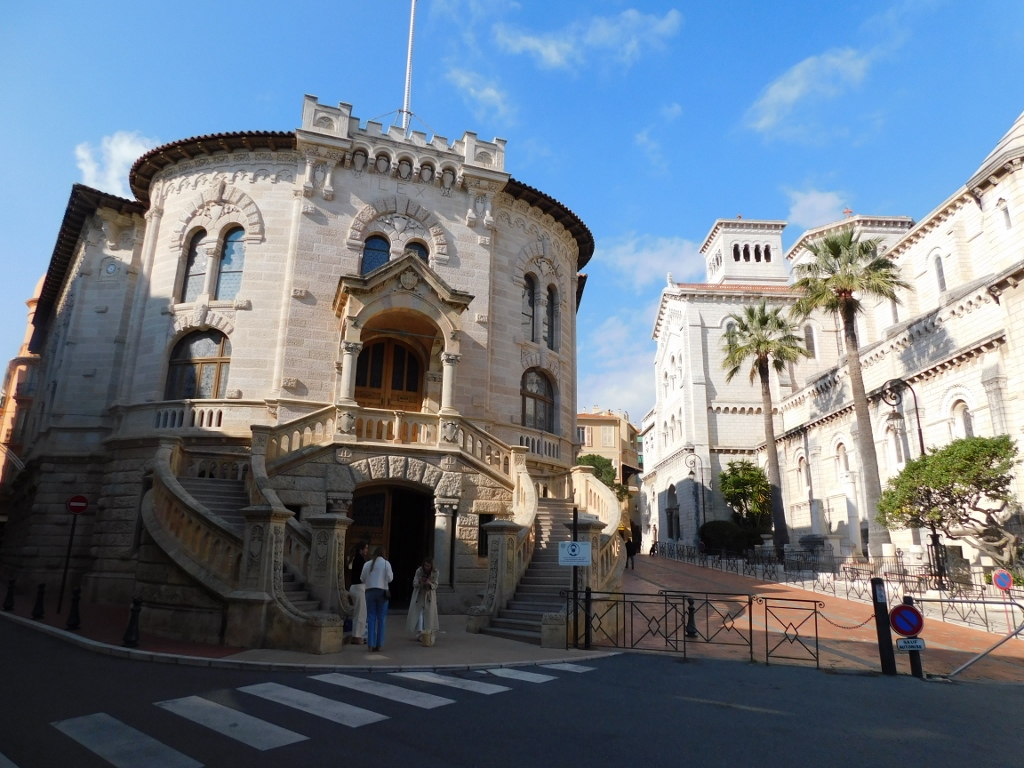 Palace of Justice
Palace of Justice
Right next to it there is Monaco’s Cathedral. The official name is the Cathedral of Our Lady of the Immaculate Conception, but it is often also called Saint Nicholas Cathedral. Namely, from 1252 to 1874, there used to be an old catholic church here named after St. Nicholas, but it was then demolished. Instead, a new church has been built and it was given a new name. The new cathedral was consecrated in 1911.
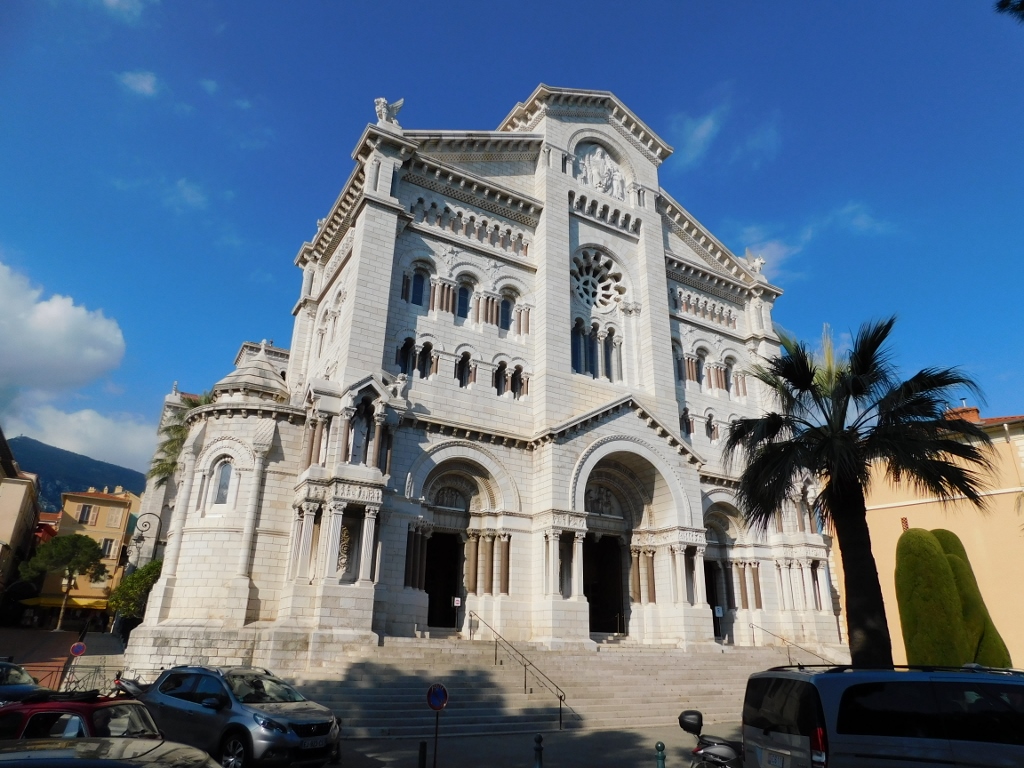 Saint Nicholas Cathedral
Saint Nicholas Cathedral
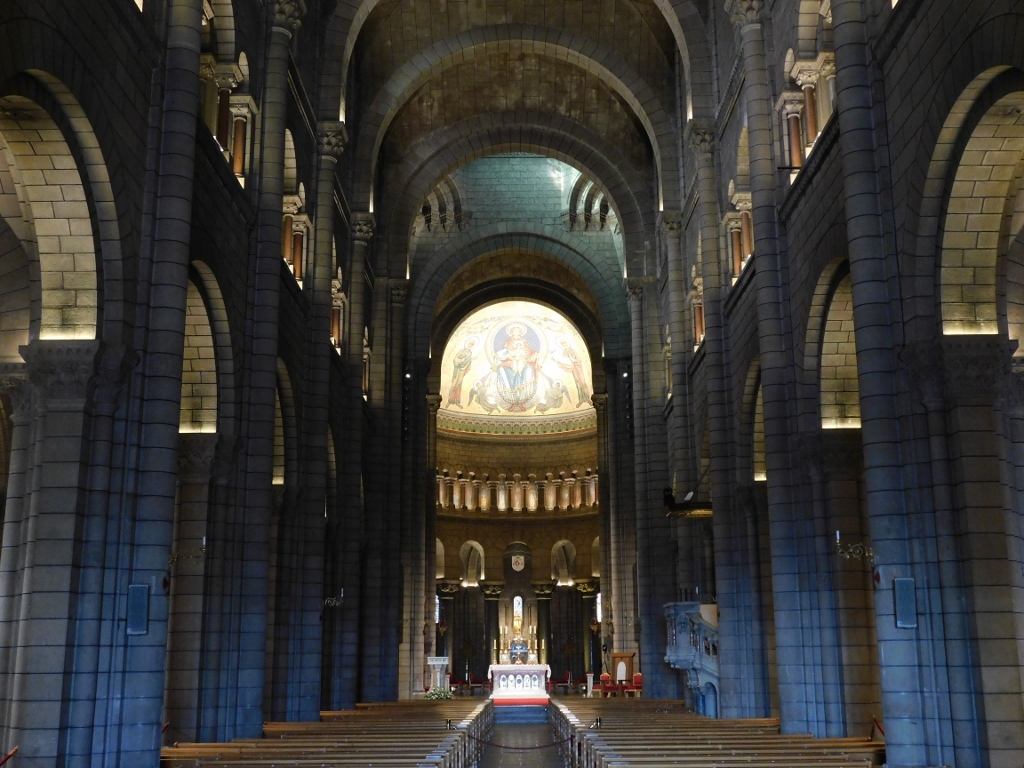 Saint Nicholas Cathedral
Saint Nicholas Cathedral
The church is an important venue in the popular culture, for this was the place where back in 1956 the famous Hollywood actress Grace Kelly married the then ruler of Monaco, Prince Rainier III. Nowadays, the church contains graves of both Grace Kelly and prince Rainier.
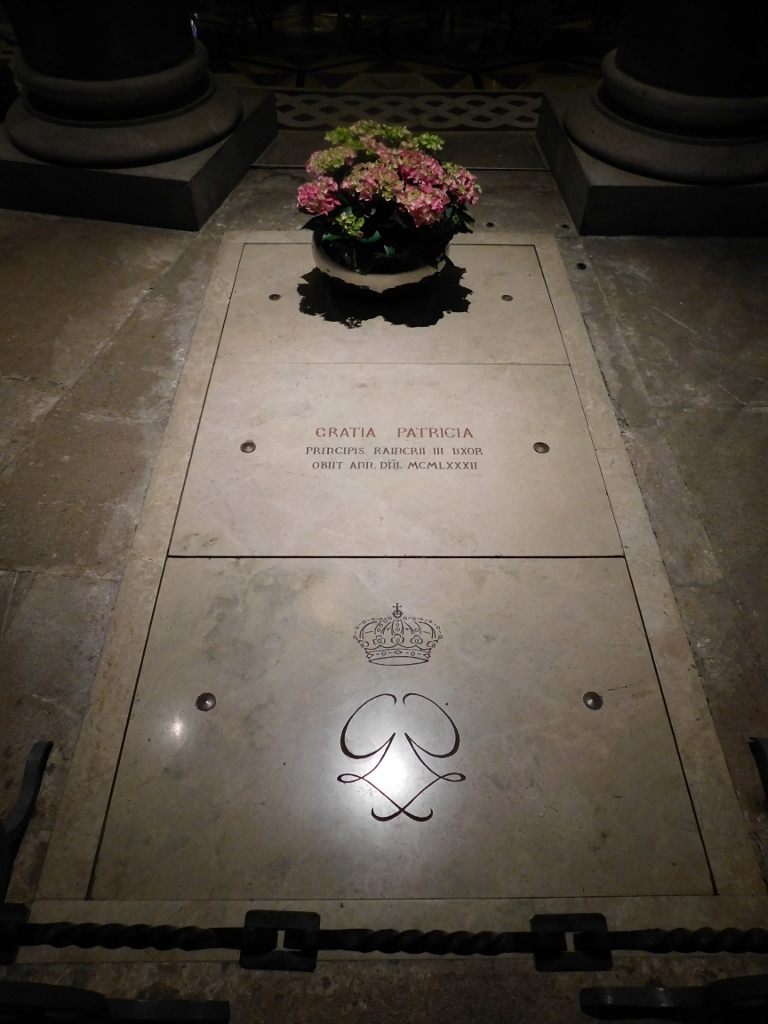 Saint Nicholas Cathedral, grave of Grace Kelly
Saint Nicholas Cathedral, grave of Grace Kelly
Right across the cathedral, there is a pretty terrace from which it is possible to look at the Mediterranean Sea, as well as see a part of ward Fontvielle. If the visitor goes a little back and then goes down within the park, it is possible to get to a fine viewpoint, but I was not in the mood, contenting myself rather by taking a photo of a part of this ward from the terrace opposite the cathedral.
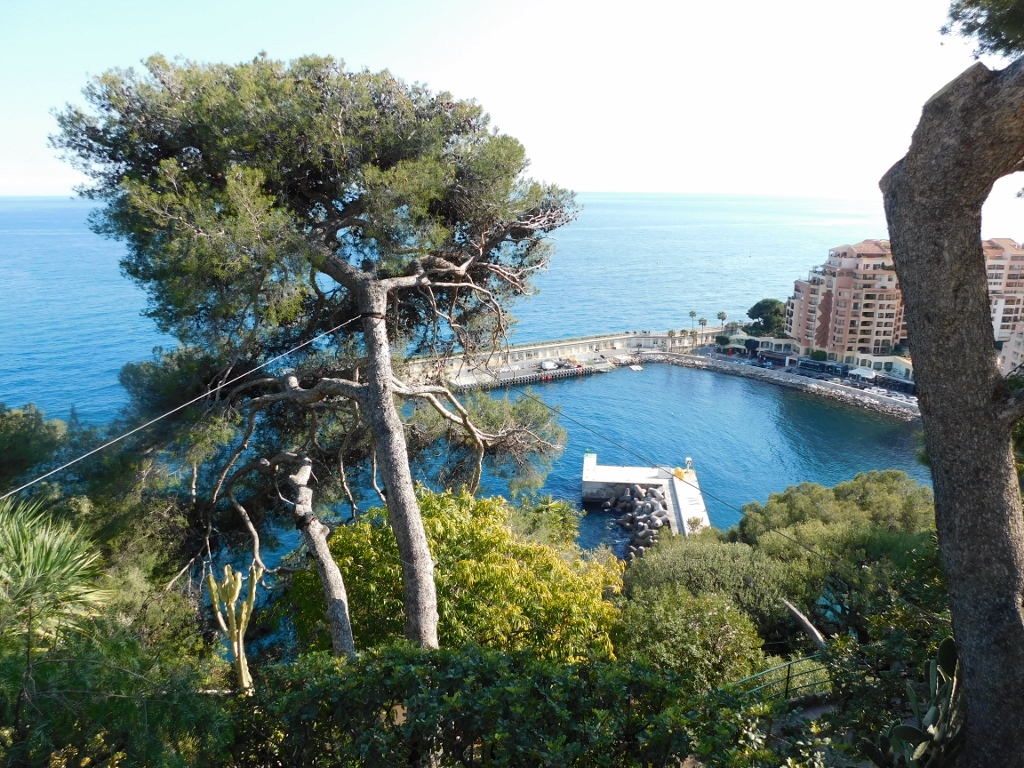 Fontvielle
Fontvielle
What makes this part of Monaco interesting is that this is the newest ward of the principality that was formed between the 1970s and the 1990s by reclaiming land. This part of Monaco may be seen partially in the photo above that actually shows the entrance into Fontvielle port.
So, I simply continued with my circular walk, heading for the Oceanographic Museum.
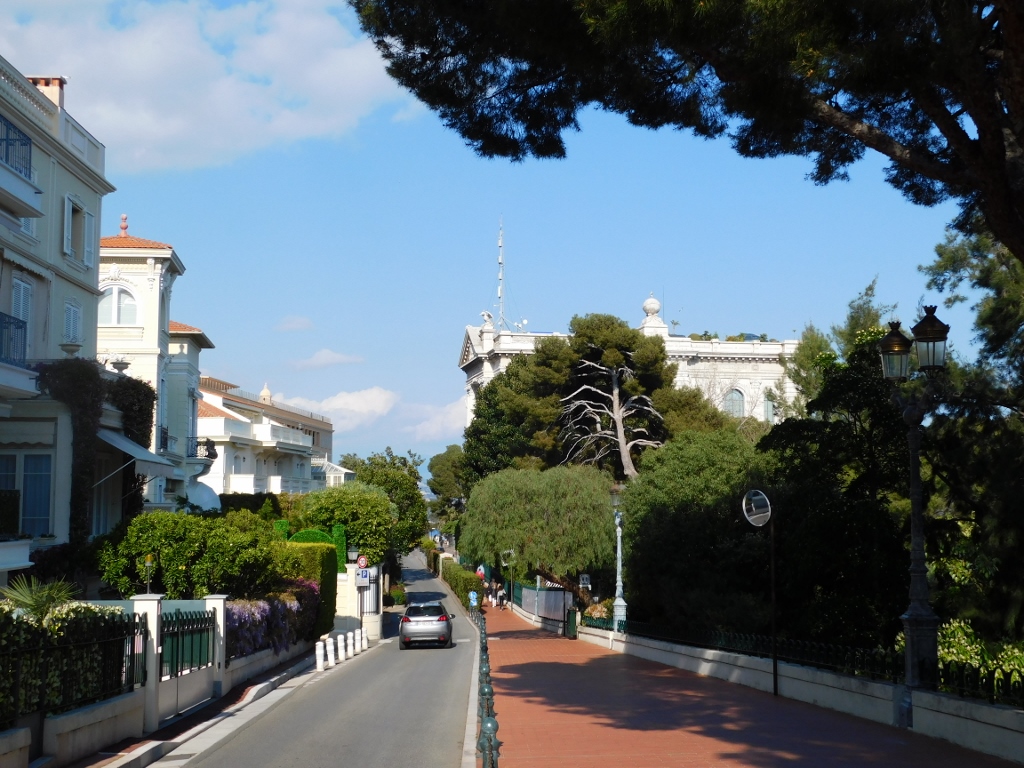 Monaco: the Oceanographic Museum is straight and to the right
Monaco: the Oceanographic Museum is straight and to the right
Soon I reached the museum.
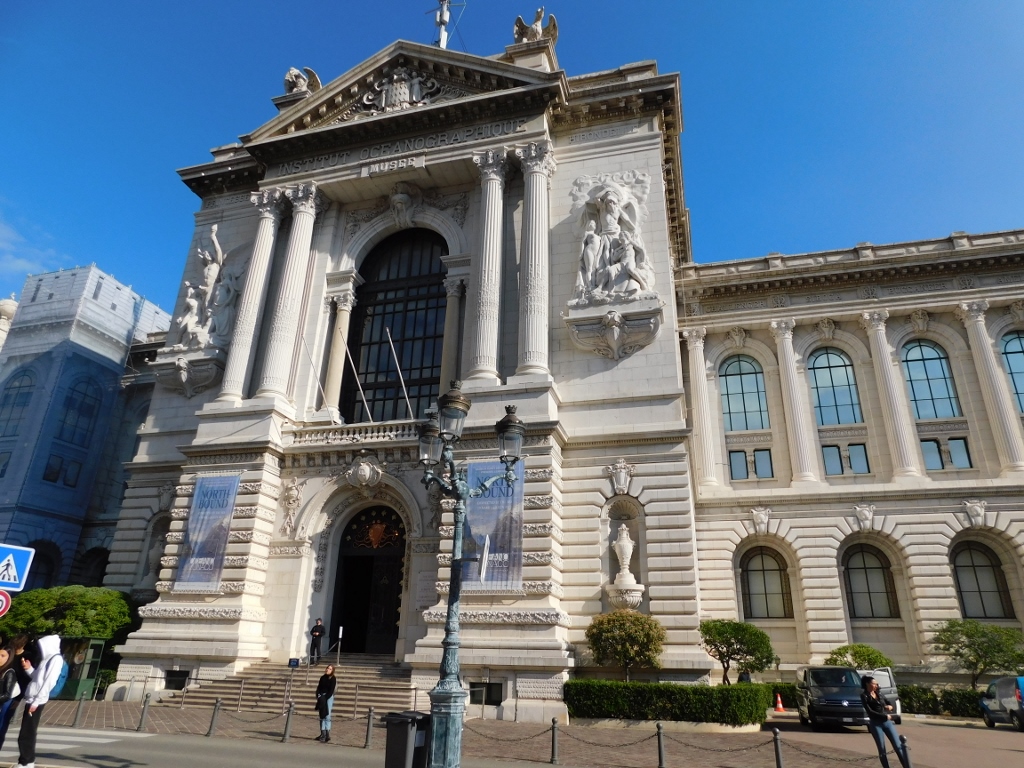 The Oceanographic Museum
The Oceanographic Museum
The Oceanographic Museum of Monaco was opened in 1910 and its construction took 11 years. The main reason for this is the fact that the museum is perched on the top of a cliff and it is particularly impressive when seen from the sea, since the building literally extends upwards from the sheer rocks.
It is interesting that in the period from 1957 until 1988, the director of the museum was the famous oceanographer, Jacques Cousteau.
In addition to the various sea animal species that can be seen here, the museum also exhibits scale models of ships, sea animal skeletons, etc. The lower sections of the museum contain aquariums with numerous fauna and flora species.
Had I had the time, I may have stopped at the museum since I love nature, animals and plants, and I’m sure I would have enjoyed the experience, but I was already rather tired and there was still a lot to be visited and seen (from the outside).
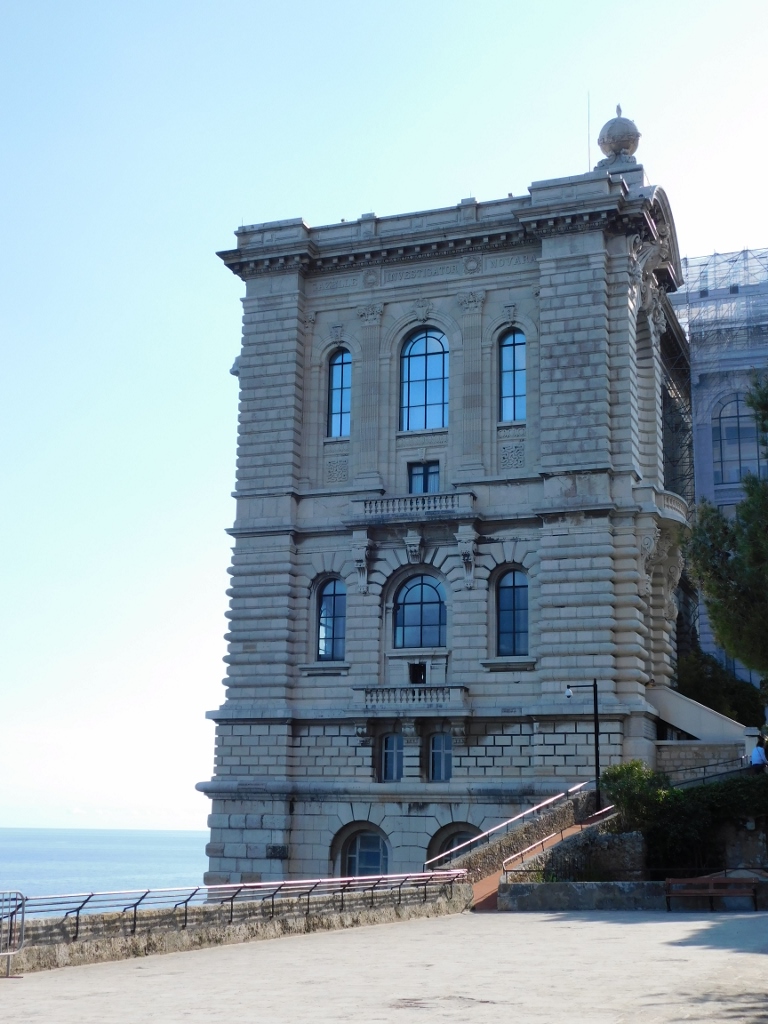 The Oceanographic Museum, view at a flanking wing of the museum
The Oceanographic Museum, view at a flanking wing of the museum
Instead of going to the museum, I continued with my walk and so I got to a park called the Fisherman’s Garden (Jardin des Pêcheurs). I had no plans to go here, but since the garden extends parallel to the street I was in, I simply started to follow a path through the park. There are numerous parks and gardens in Monaco, but visiting them would require much more time that what I had available. This happened by chance, but it was nice and interesting nonetheless.
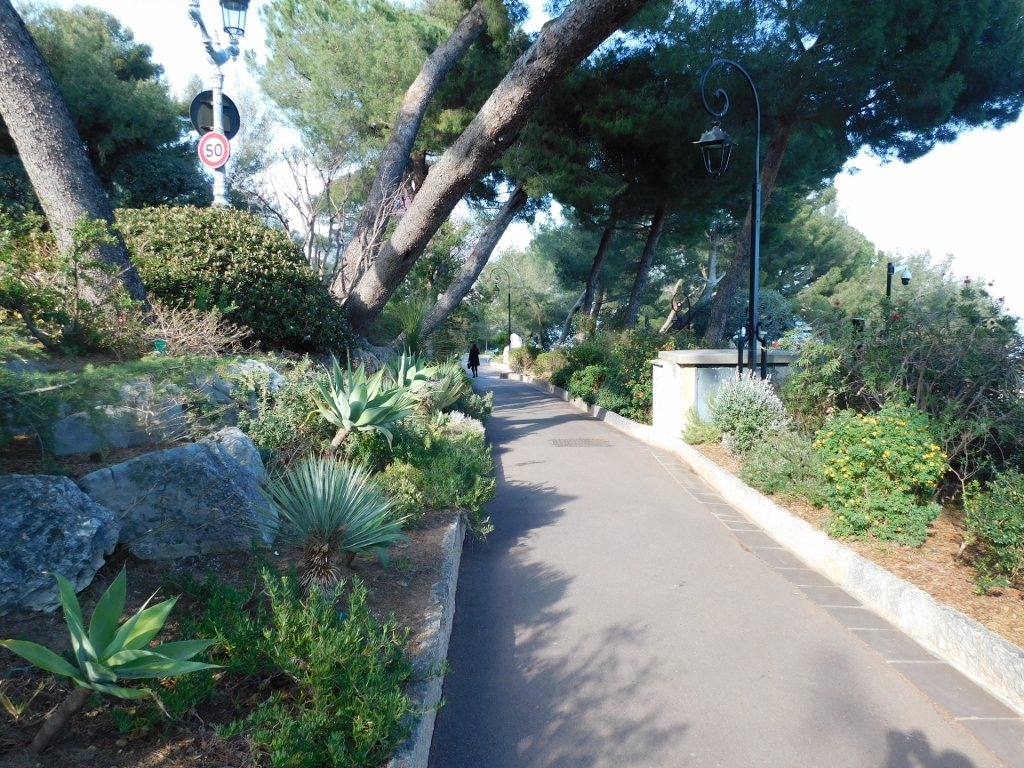 Fisherman’s Garden
Fisherman’s Garden
Namely, I got lucky here and thus I managed to take photos of a couple of cute birds.
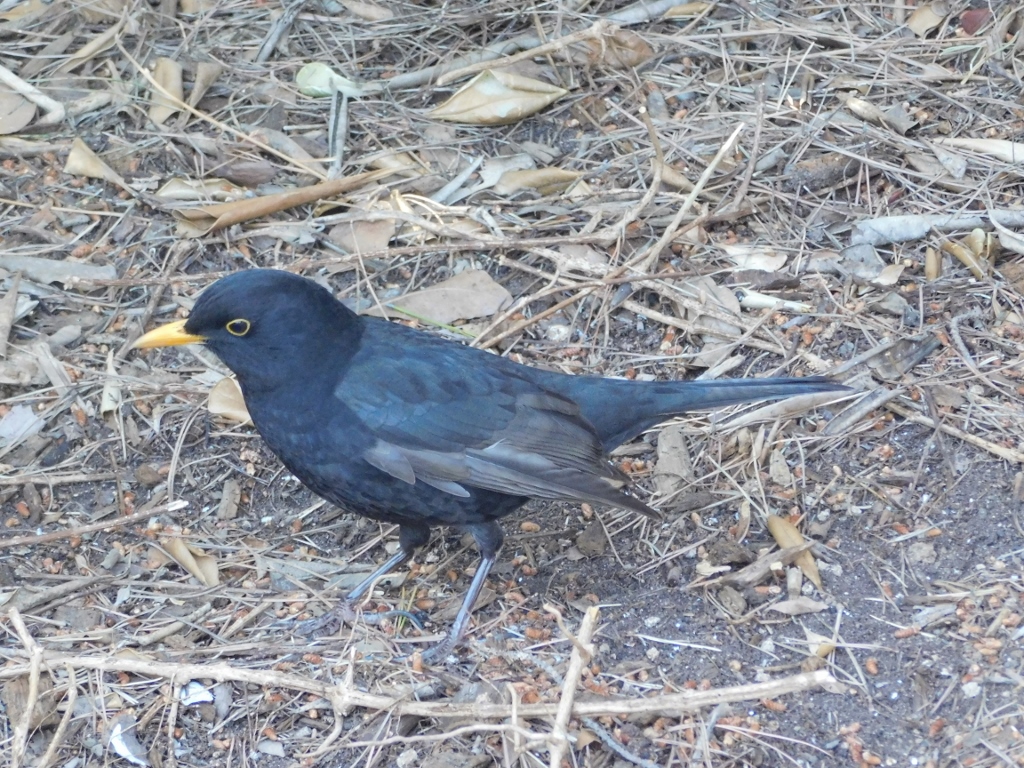 Common blackbird (Turdus merula)
Common blackbird (Turdus merula)
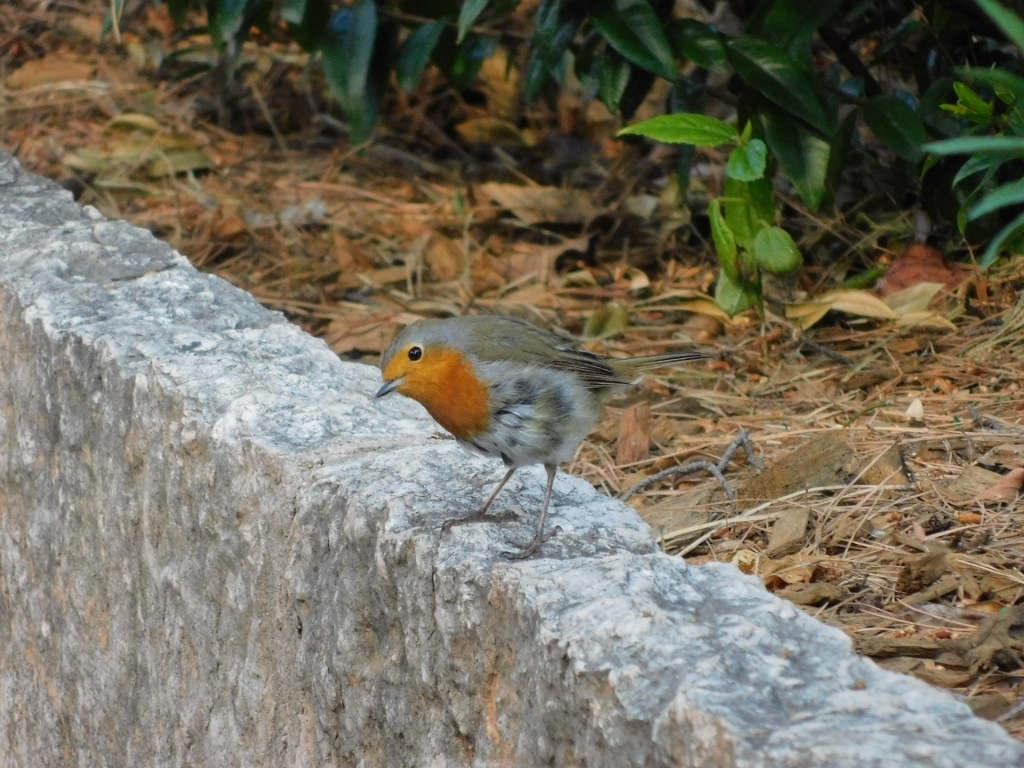 European robin (Erithacus rubecula)
European robin (Erithacus rubecula)
Soon I reached a spot from where again I had a stunning view at Hercules Port (Port Hercule) and some parts of Monaco.
 Hercules Port
Hercules Port
At the end of the park I also walked past the Picture Frame sculpture, but if I had tried to make a selfie there, I wouldn’t have succeeded in taking a photo of the sculpture itself, which has the shape of a frame. For this reason, the following photo shows the frame without me, as well as parts of the park. I am not that important as to be in the photo.
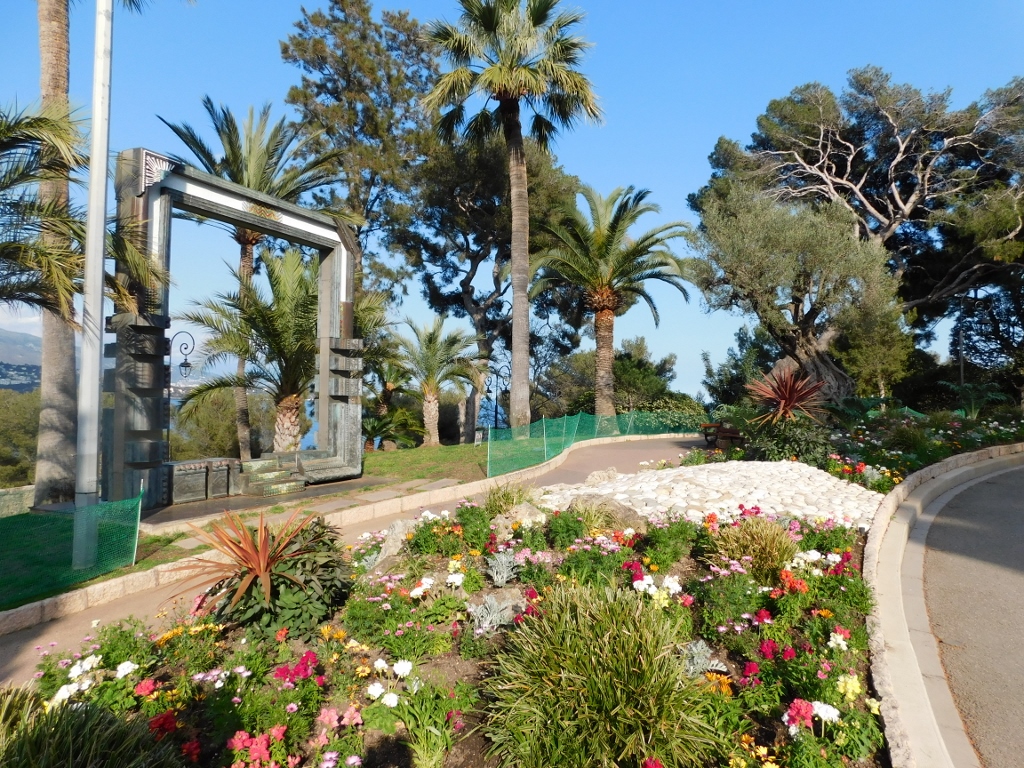 End of the Fisherman’s Garden and the Picture Frame sculpture
End of the Fisherman’s Garden and the Picture Frame sculpture
And then, following an avenue with a path for pedestrians, I went down to Hercules Port. The path and the avenue are separated by a line of trees and very pretty bushes, especially when the sunlight hits their leaves.
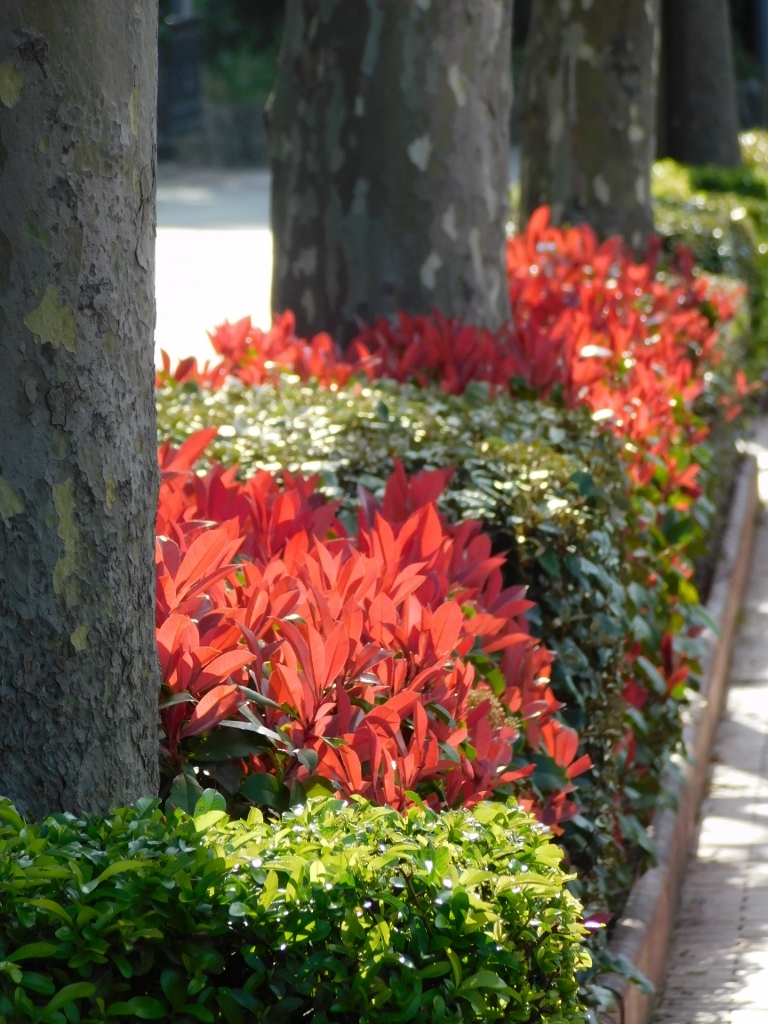 Monaco, a detail
Monaco, a detail
When I descended to the level of the port, I came across numerous metal fences and almost a construction site, but pedestrians were allowed to pass through, so I continued in that direction. Spectator stands had already been assembled and I must say I did not find it clear why this was, as it seemed at least to me to be far to early for the Formula 1 race – the Monaco Grand Prix. But, according to what I read later on, it takes as many as six weeks for the circuit to be built, so in all likelihood this was indeed a part of the preparations.
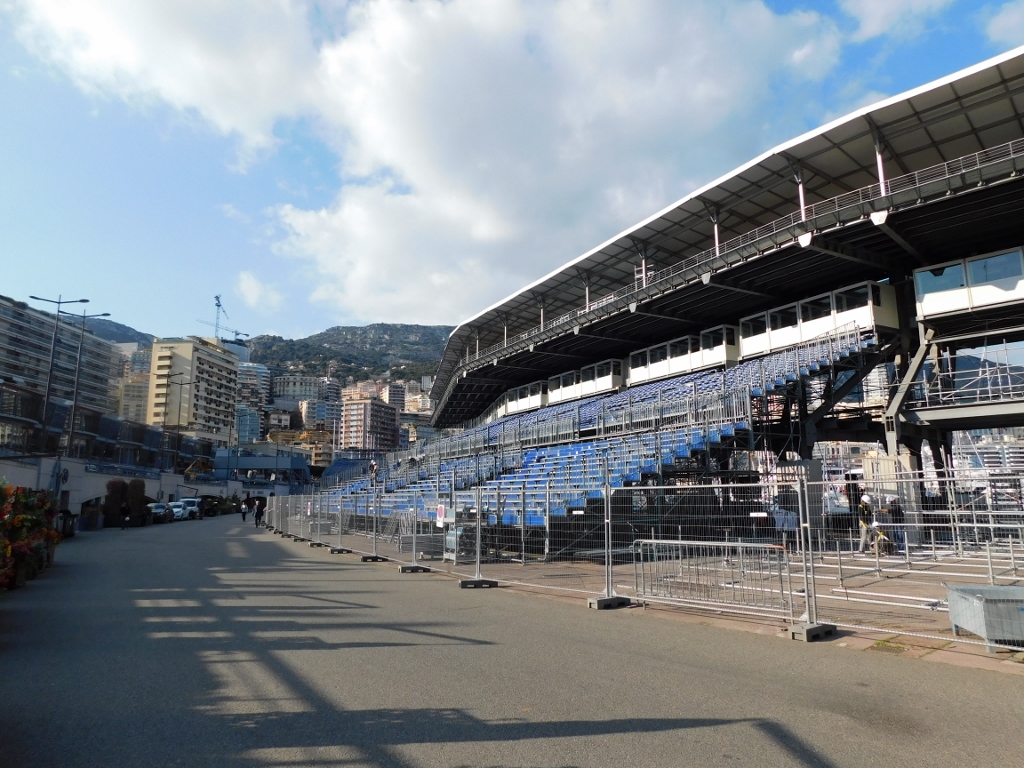 Monaco, spectator stands for a race
Monaco, spectator stands for a race
Be as it may, I walked through quite nicely and then I even came across a café in-between all these stands and fences, but there was no traffic, so I sat there in order to rest a little and also to drink my favourite panaché.
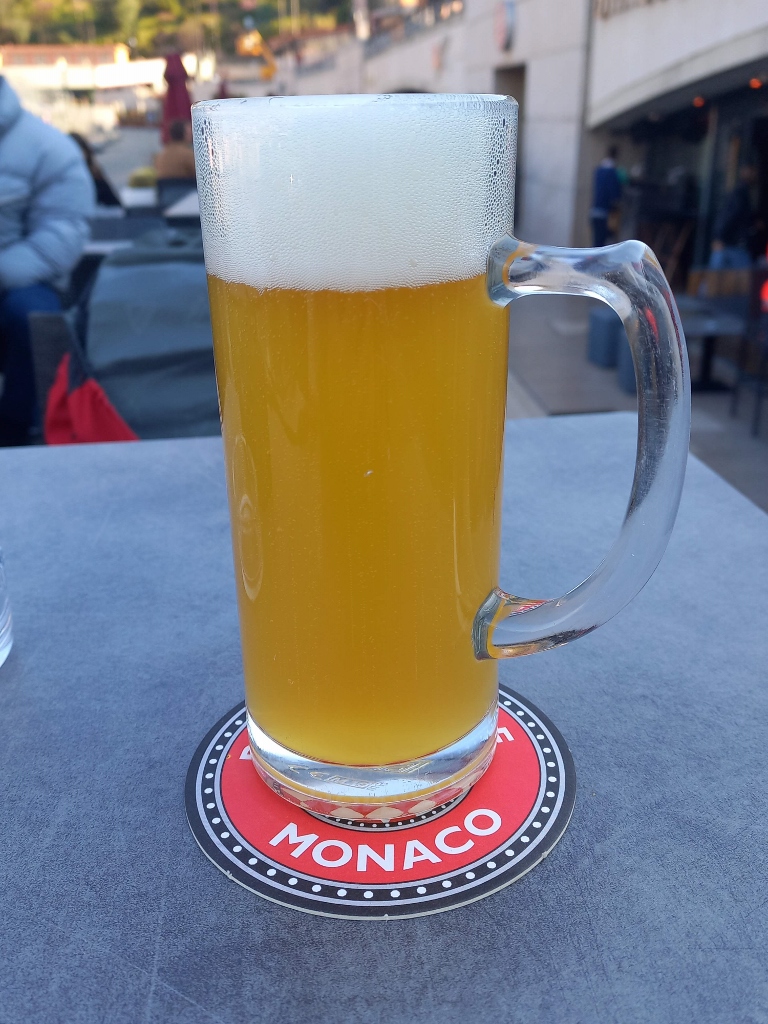 Monaco, a detail
Monaco, a detail
Then I continued walking by the port.
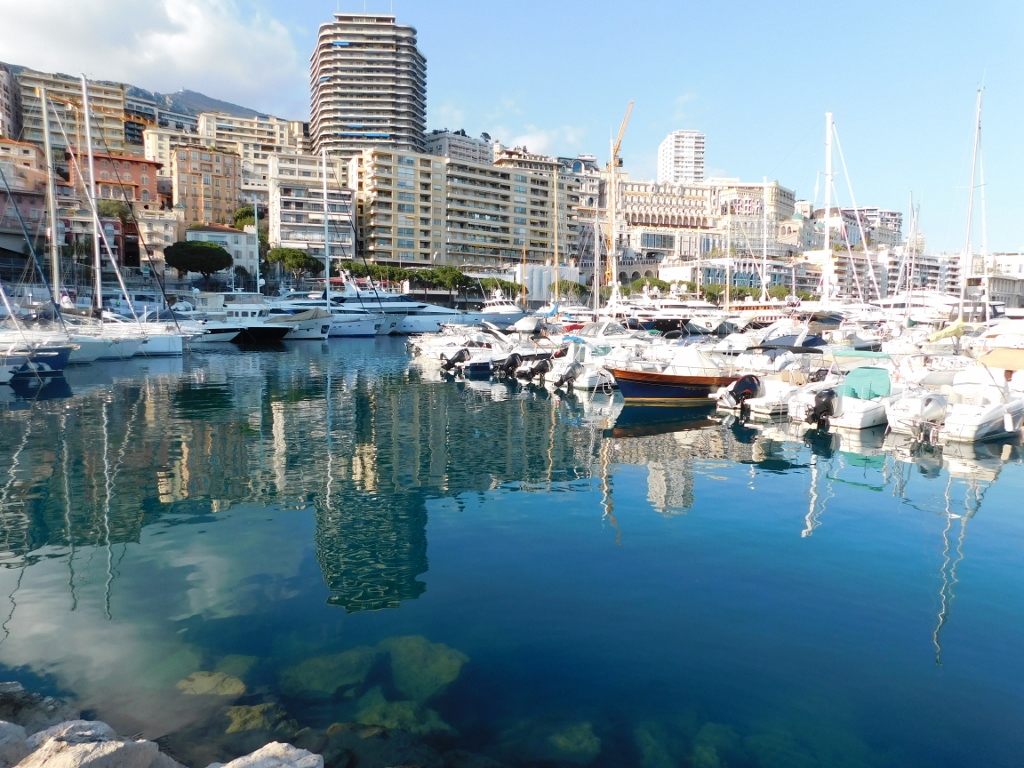 Hercules Port
Hercules Port
Hercules Port is a natural bay, as well as the only port in Monaco with deep water. This is certainly a requirement here, for the depth of the water directly reflects the depth of the pockets of the owners of different vessels parked in the port. Of course, it is possible to see smaller motorboats as well, but there are certainly large yachts at display. Depending on the time of the year, the season and the events taking place in Monaco, one can also see various huge yachts, as well as cruisers. For all these reasons it is important that the water here is deep.
 Hercules Port
Hercules Port
Once I had made an almost entire circle walking beside the port, I got to the last pier on the left-hand side where I saw several sculptures. If you look at the following photo more closely, you will be able to notice three sculptures. In the foreground there is a bronze sculpture of Ulysses at a ship’s wheel, behind it is the Star on Pier and all the way in the back is Et Purus no. 1 dedicated to the fight against doping in sports.
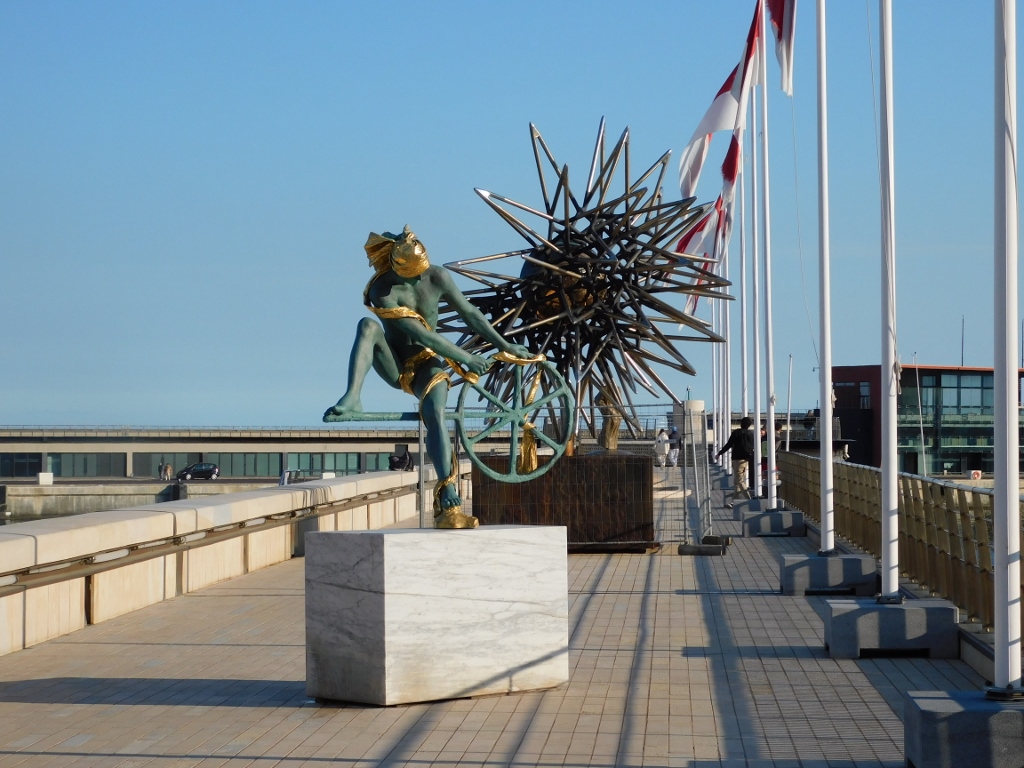 Hercules Port, sculptures on the pier
Hercules Port, sculptures on the pier
The walking path soon brought me to the famous tunnel Larvotto named after the most eastern ward of Monaco. Still, this is not the reason for the tunnel’s fame; it’s the Formula 1 races.
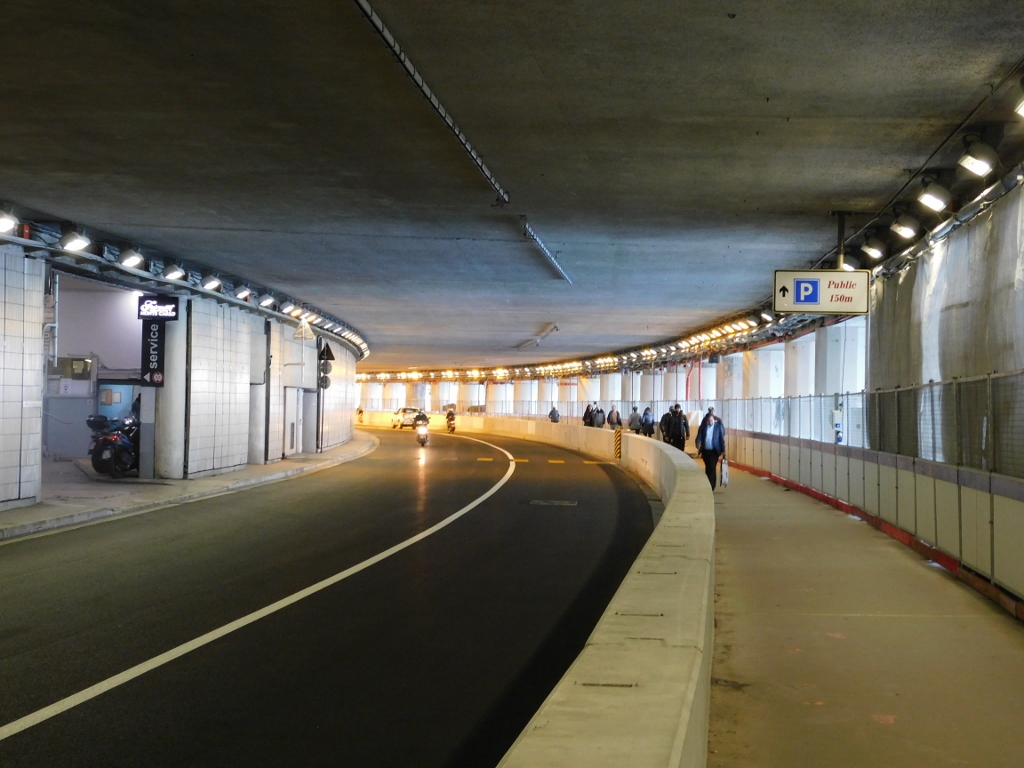 Larvotto tunnel
Larvotto tunnel
Several hundred metres farther I got to the Princess Grace Japanese Garden that is situated precisely in Larvotto. Of all the parks and gardens in Monaco, this one seemed to be mostly on my way, for after this visit my plan was to head back to the train station.
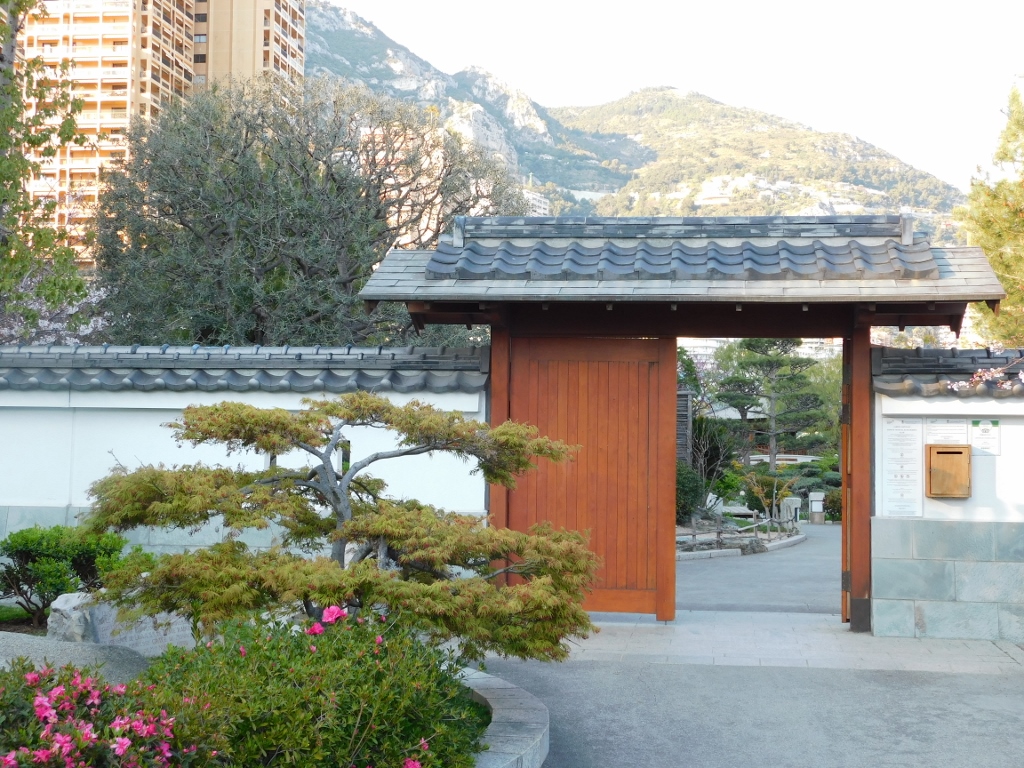 Japanese Garden
Japanese Garden
In front of the very entrance into the garden I came across a blossoming cherry tree. I don’t think it can get “more Japanese” than that.
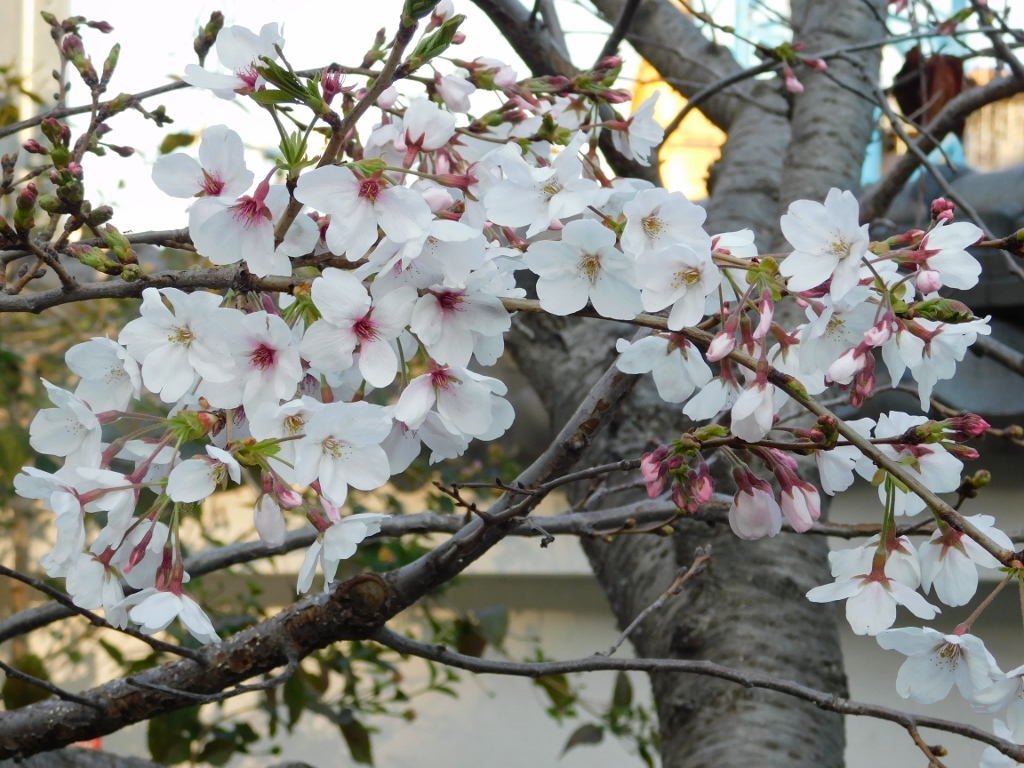 Blossoming cherry tree at the entrance into the Japanese Garden
Blossoming cherry tree at the entrance into the Japanese Garden
The garden consists of several sections, including also a zen-garden for meditation, and I walked around quite nicely, following different winding paths and walking over small bridges.
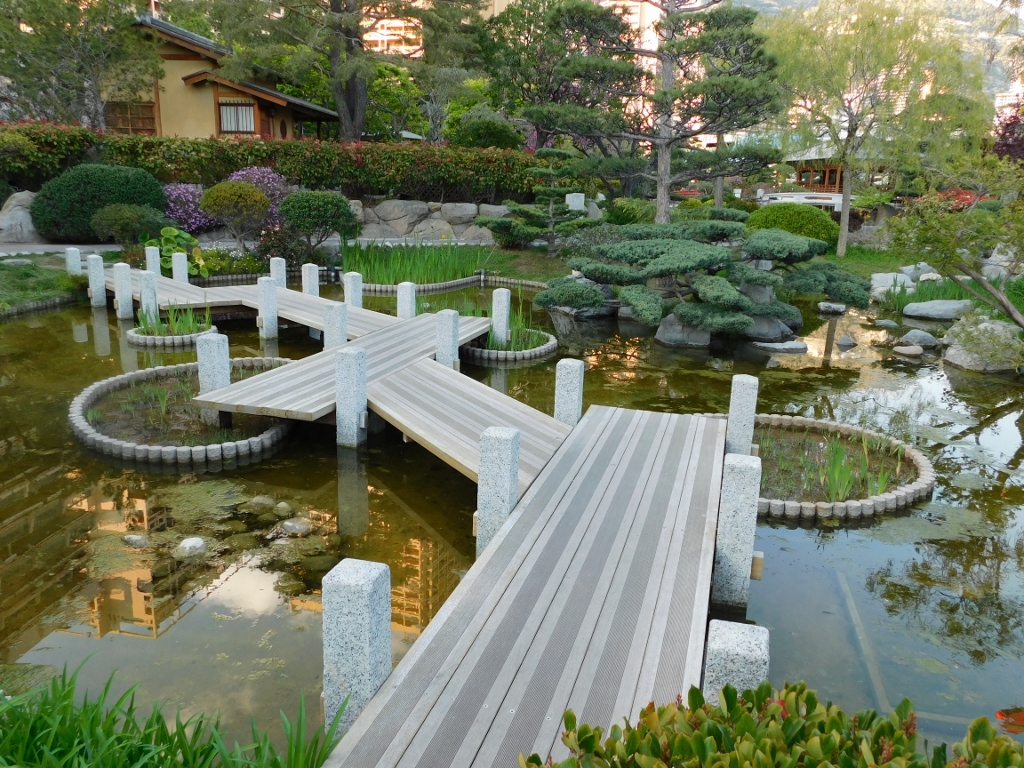 Princess Grace Japanese Garden, a detail
Princess Grace Japanese Garden, a detail
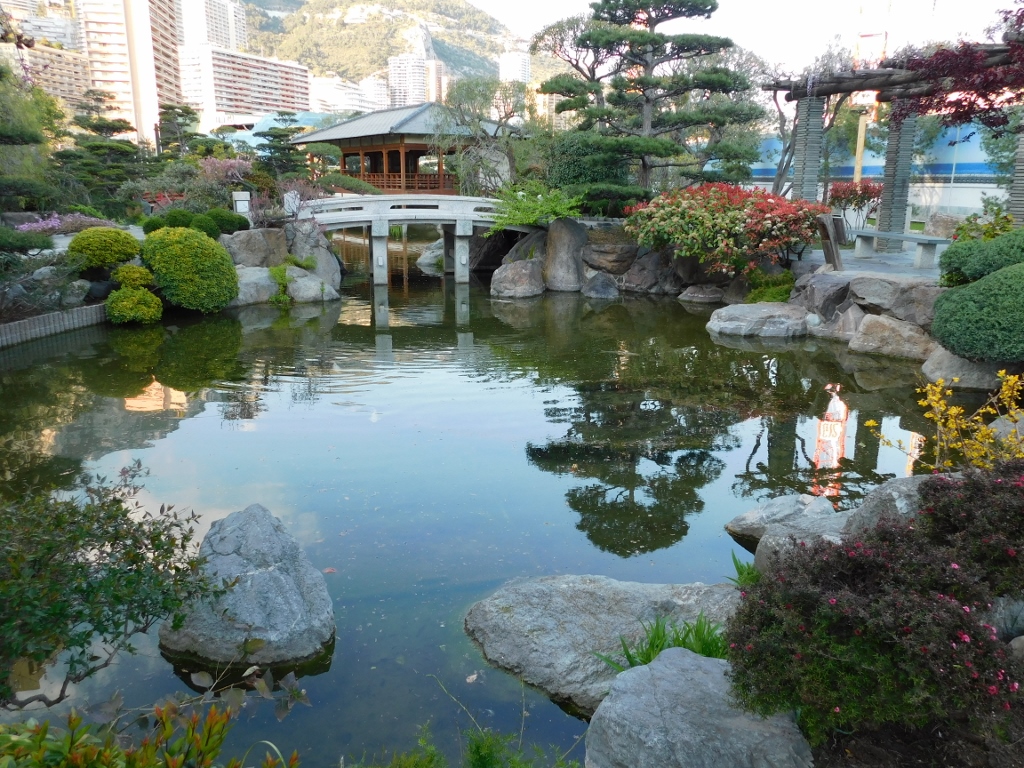 Princess Grace Japanese Garden, a detail
Princess Grace Japanese Garden, a detail
Needless to say, this would not be a true Japanese Garden if there were no koi carp in the pond. This is a decorative type of carp developed over time in the Far East for the purpose of adorning fish ponds and water gardens. The main colours found in this carp subspecies are white, red, black, yellow and blue. Here, at the Princess Grace Japanese Garden, there is even an information board showing the different varieties of the koi carp.
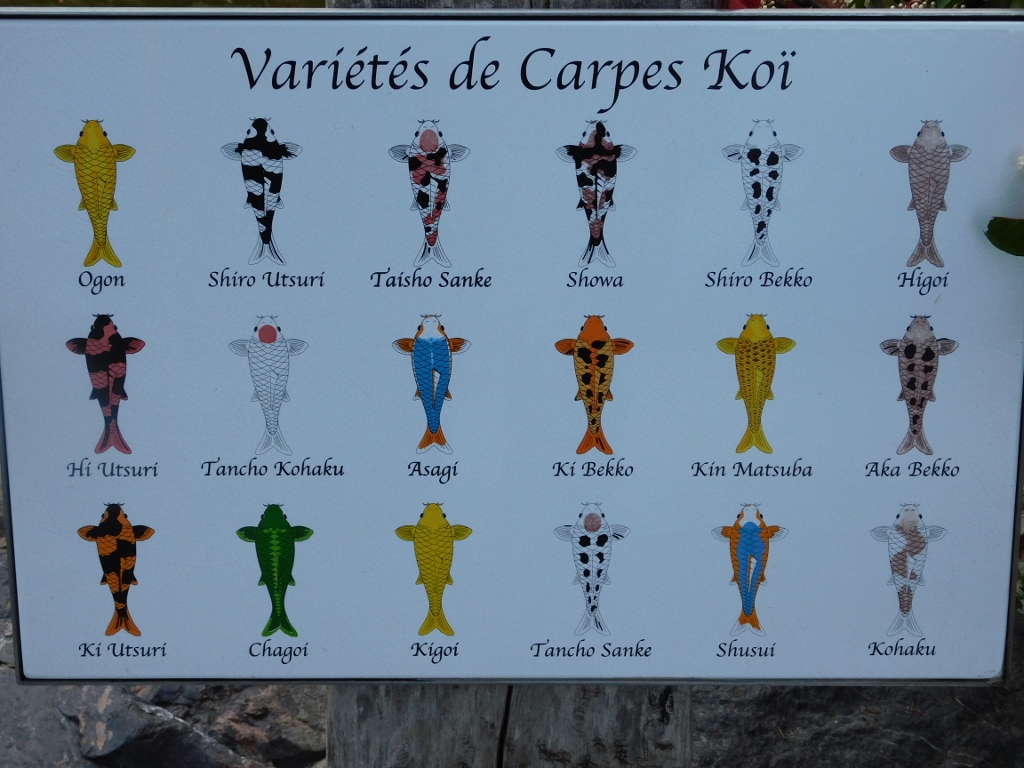 Koi carp, board with the variations on the given subject
Koi carp, board with the variations on the given subject
The pond is home to numerous koi carps of different colours, but not all of them were keen on striking a pose.
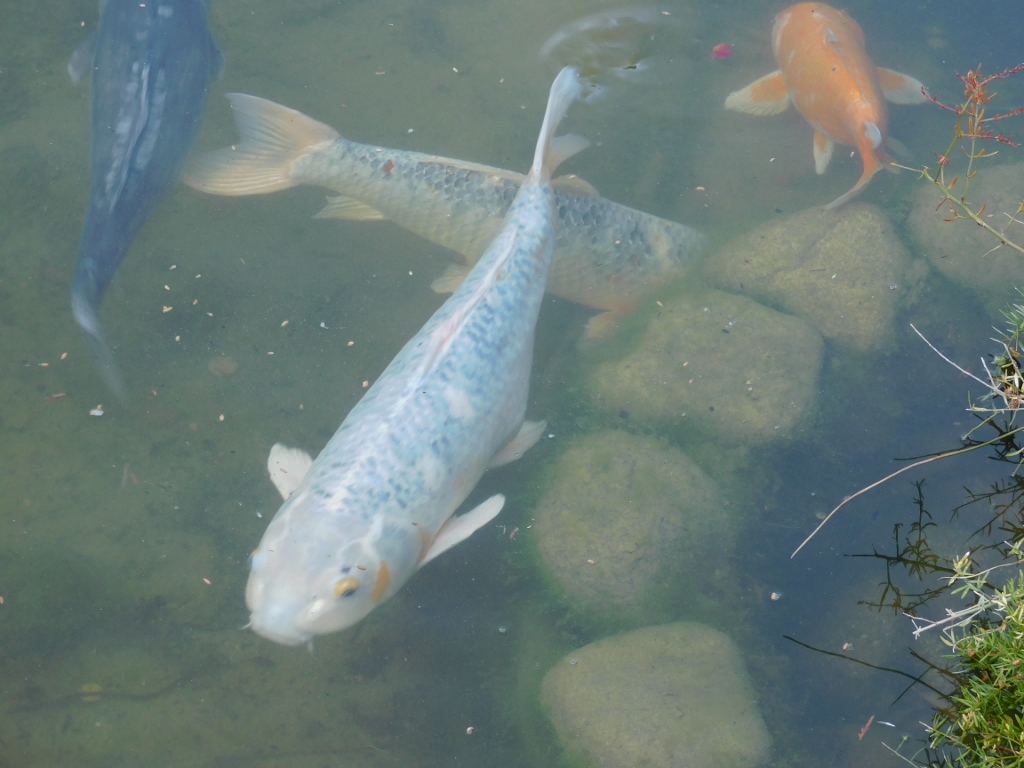 Koi carp, variations on the given subject live
Koi carp, variations on the given subject live
Some sites found on the internet say that the garden is open until the sunset. This is not quite true and as far as I could see even in summer, when the Sun sets later on, the garden closes at 6 pm. Admittedly, at the beginning of April, at the time when I was visiting here, the garden was in a shade all the time and not only at 6 pm, so judging by some of the residents it was the time to go to sleep. I got the message and headed for the exit. The official reason for me leaving the garden was that one of the guards went around reminding a couple of us that it was the closing time.
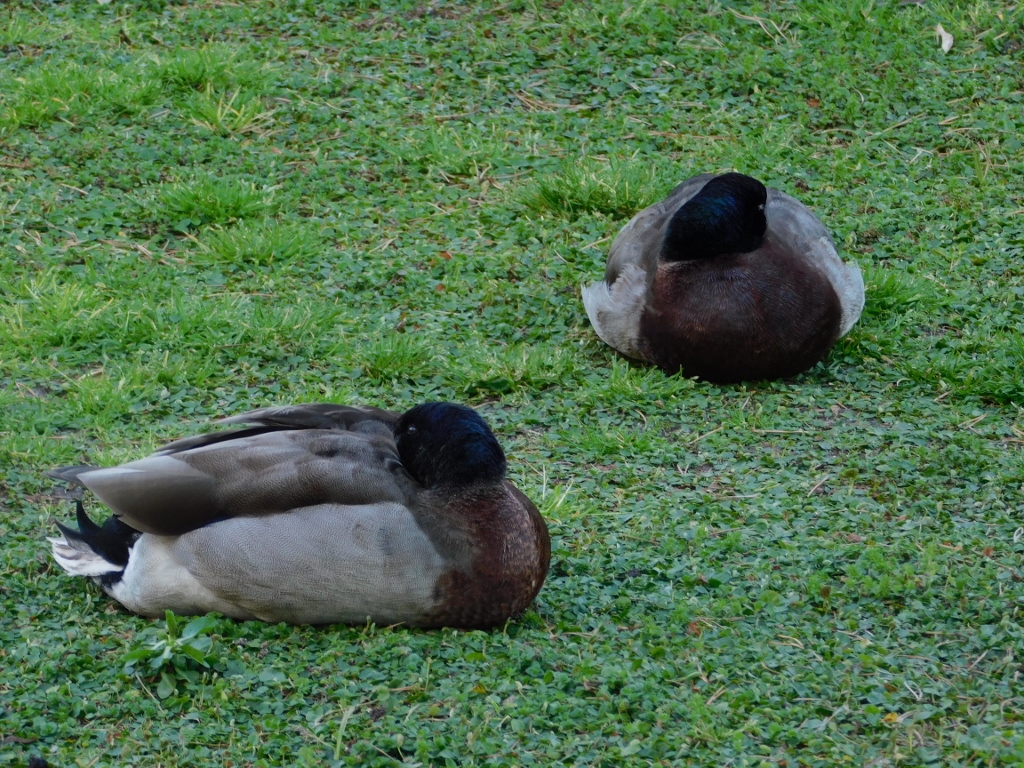 Mallards at the Japanese Garden are ready for the night
Mallards at the Japanese Garden are ready for the night
As soon as you leave the Japanese Garden, you come across a square concrete pool over which there is a diagonal pedestrian bridge. While I was crossing there I noticed a few more mallards in the water of the pond, but these were quite awake. They were a mallard mum with mallard ducklings and after the nice bath the family was supposed to get out of the water. There were some rocks used for the climbing out and I found the sight mesmerising. The ducklings were incredibly cute, while the mom was patient. Only when the last duckling successfully got out, she was ready to leave the pool, too.
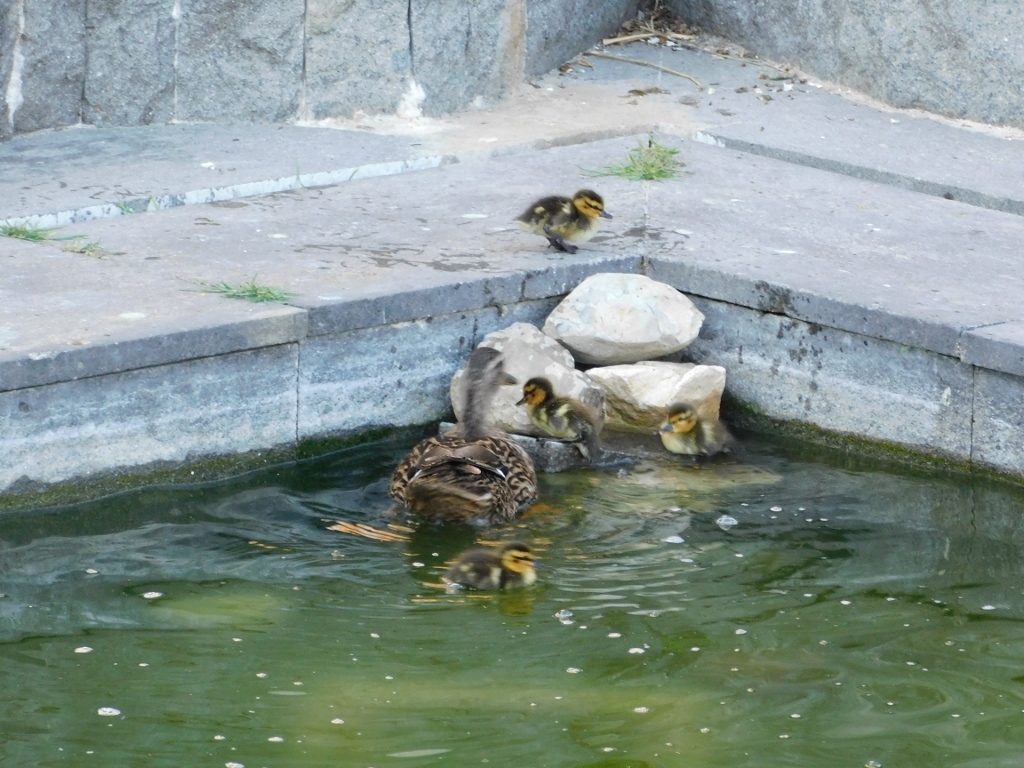 Mallard mom and ducklings
Mallard mom and ducklings
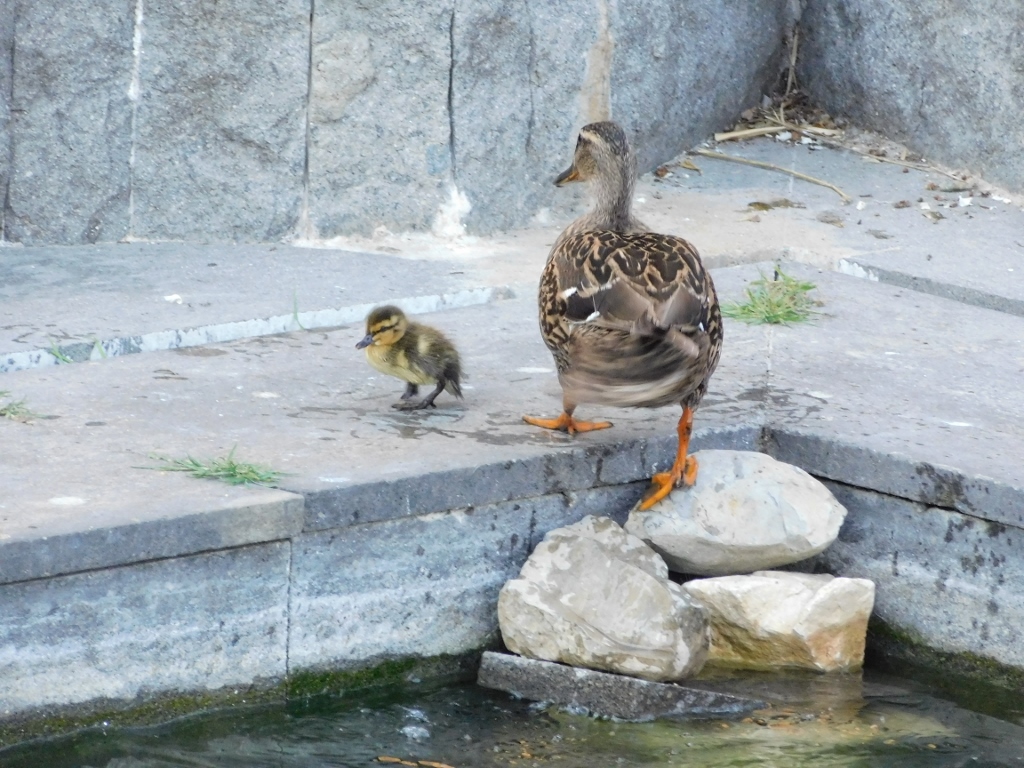 Mallard mom and ducklings
Mallard mom and ducklings
Some 400 m farther I came to yet another famous place linked to the Monaco Grand Prix. It is one of the most famous curves in this whole travelling circus called the Formula 1 races – the Fairmont Hairpin curve. Over time this curve has changed its name depending on who owned a large hotel beside which the curve is located. Nowadays, this is the Fairmont Hotel and hence the name. Needless to say, I had to make a selfie here in order to send it to some of my friends who are interested in car races.
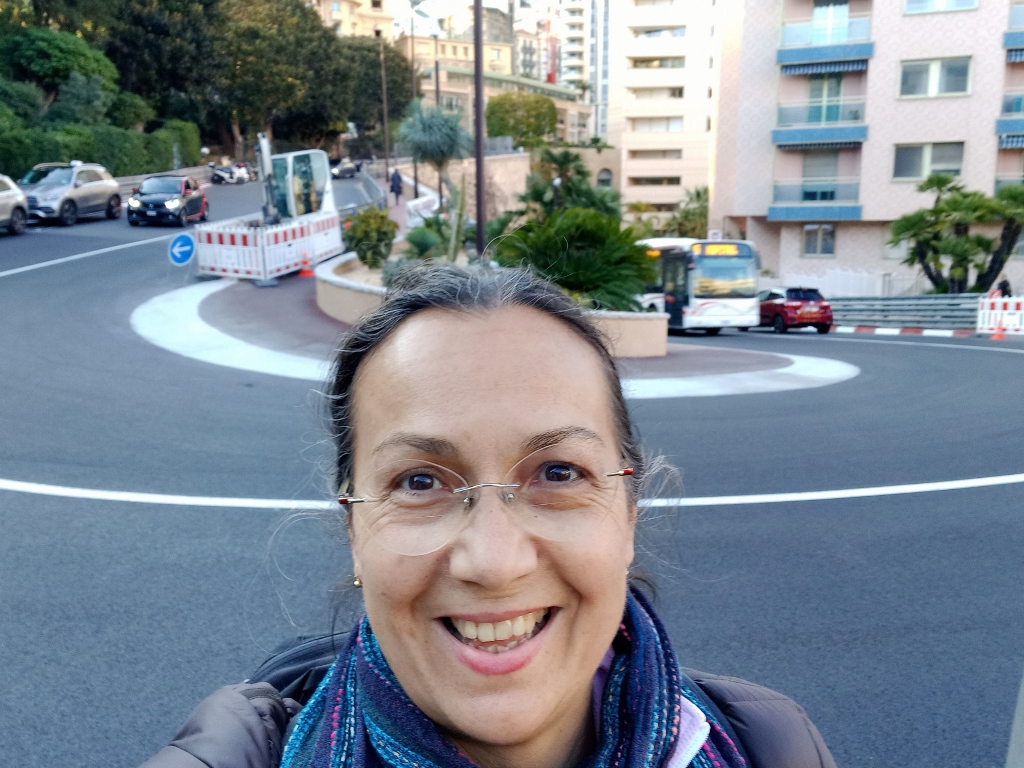 By the Fairmont Hairpin
By the Fairmont Hairpin
What makes the Formula 1 races in Monaco particularly interesting is that this is the place with the curve where the drivers have to go slowest, but there is also a section in which the drivers may reach the highest speeds. For this reason, this urban curve deserves another photo.
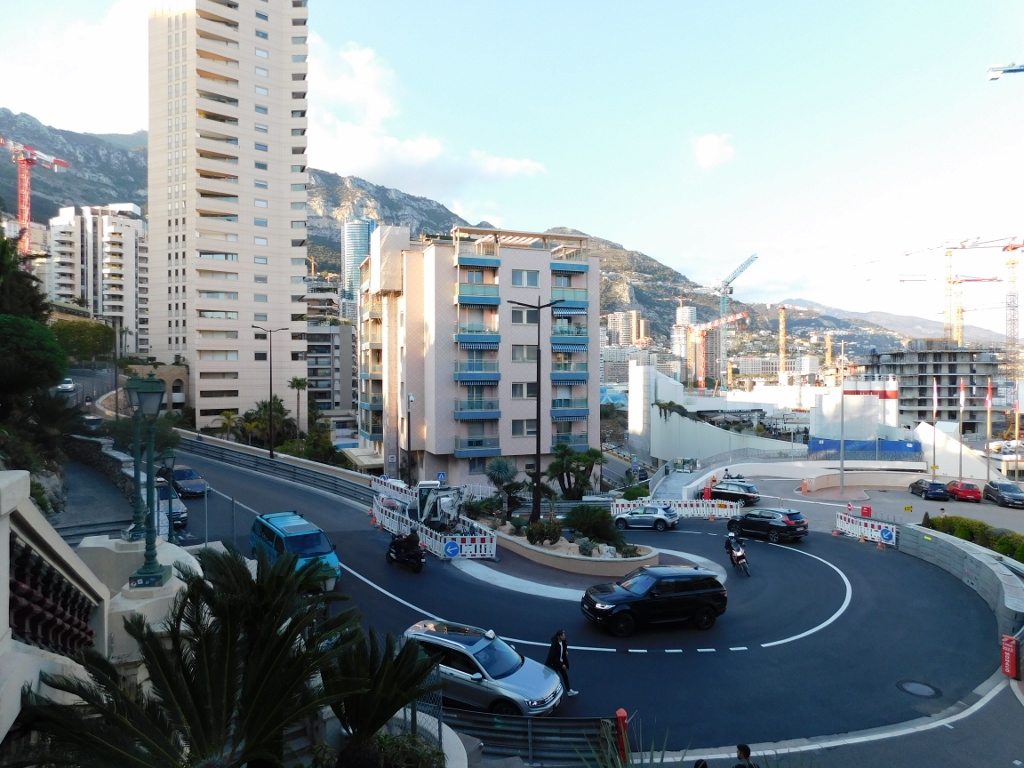 Fairmont Hairpin
Fairmont Hairpin
From here, a staircase zigzags up towards a plateau in front of the Casino. After the staircase, I continued along a passage leading by a number of impressive buildings that on their ground floors contain equally impressive expensive shops with different exclusive goods.
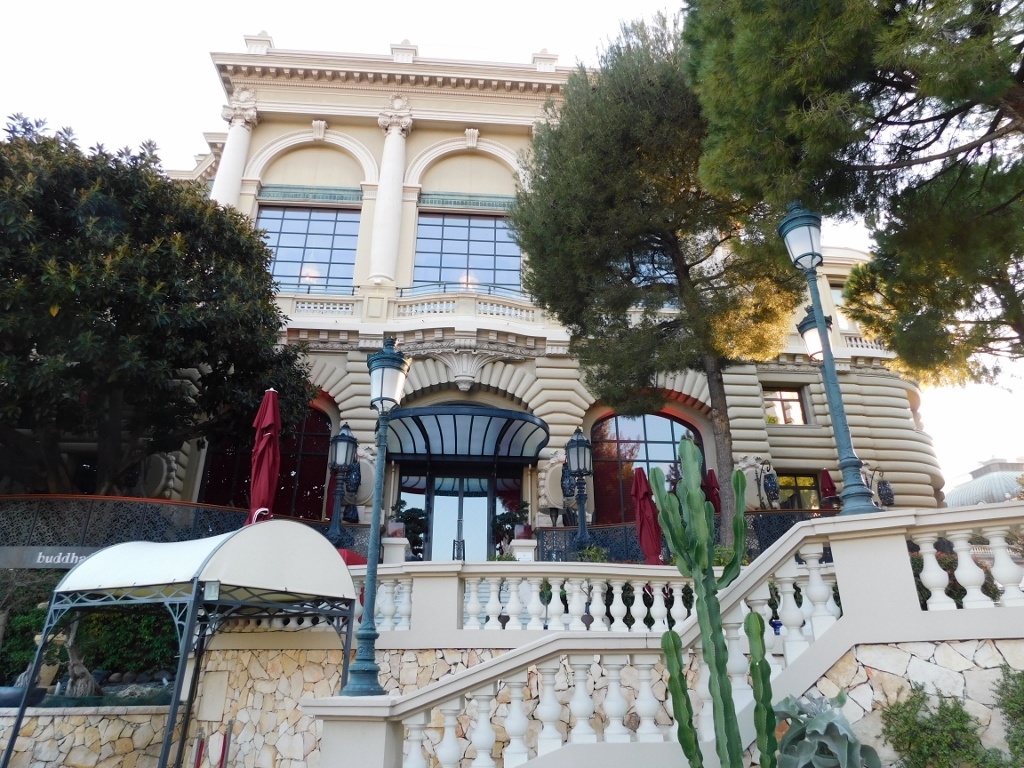 Staircase by the Fairmont Hairpin that leads towards the Casino
Staircase by the Fairmont Hairpin that leads towards the Casino
By the way, here I was well within the ward of Monte Carlo, which is also the biggest one in Monaco. This term is often used for a larger area that incorporates a couple of other wards, but this is all relative taking into account that the principality, as I’ve already mentioned, covers the surface area of only 2 sq. km.
Be as it may, I walked directly to the famous Monte Carlo Casino opened in 1865. From the today’s point of view, it is interesting that the idea to open a casino here in the first place came out of the desire to prevent the bankruptcy of the ruling Grimaldi family!
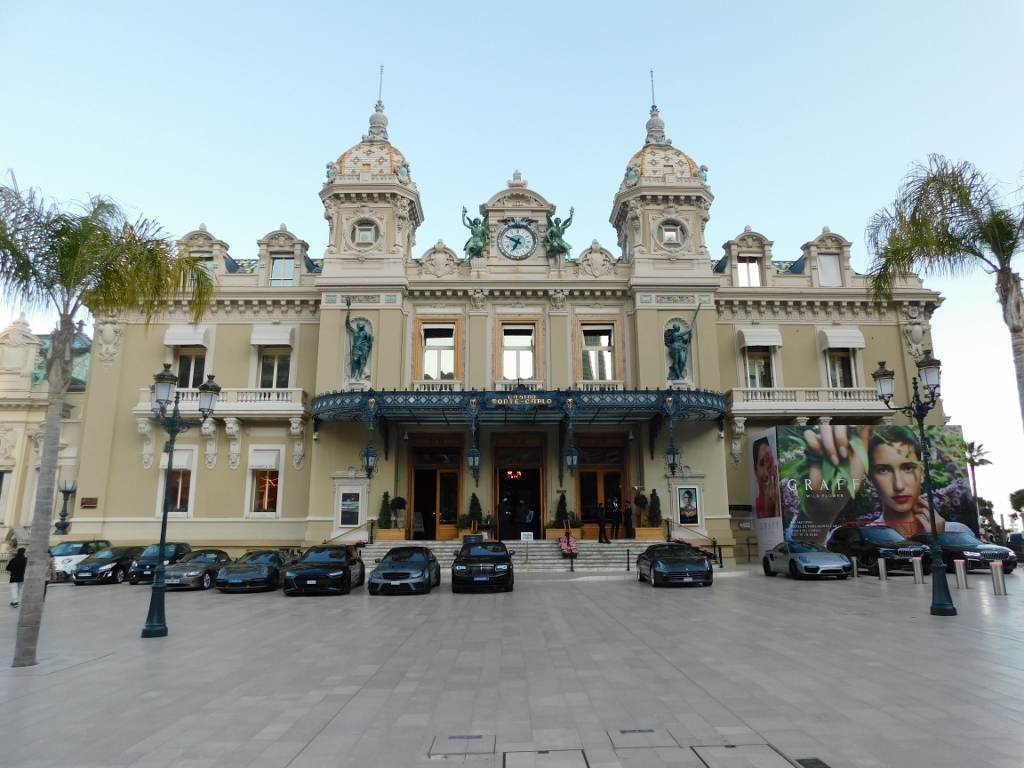 The Monte Carlo Casino
The Monte Carlo Casino
Nowadays, there is no danger whatsoever of something like this ever happening. As an illustration of this claim of mine, have a look at the following photo showing some of the cars parked in front of the Casino.
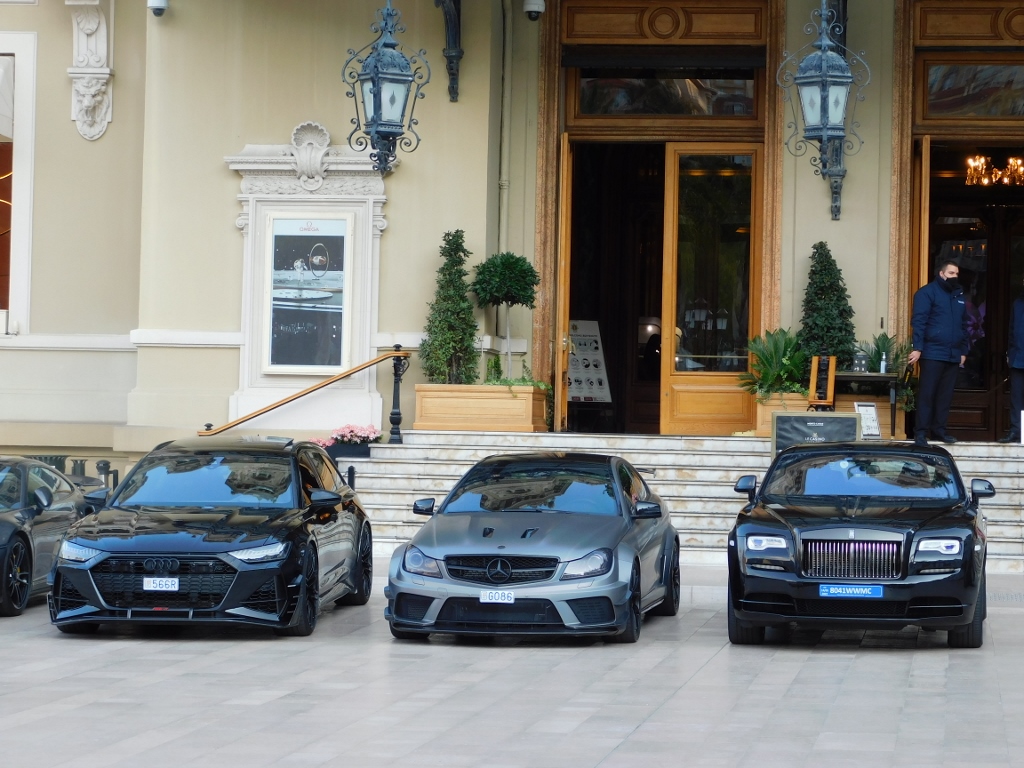 The Monte Carlo Casino, a detail
The Monte Carlo Casino, a detail
Directly behind the Casino, within the scope of the same building, there is the Opera of Monte Carlo (Opéra de Monte-Carlo) which is in fact a part of the casino, since there was little entertainment in Monaco during the 1870s and so a decision was taken to add a concert hall to the casino.
By this time, however, I was seriously tired and so I was no longer interested in any more sightseeing, contenting myself only with what I could see on my way back to the train station.
As for the Casino itself, I did enter there many years ago when I travelled here with my brother, but gambling leaves me completely cold and so I had no intention of trying to get in at all this time around. Later I actually read that nowadays people who do not gamble can enter only as a part of some tours and then they even have to pay for the tickets.
Here is what I think about it:
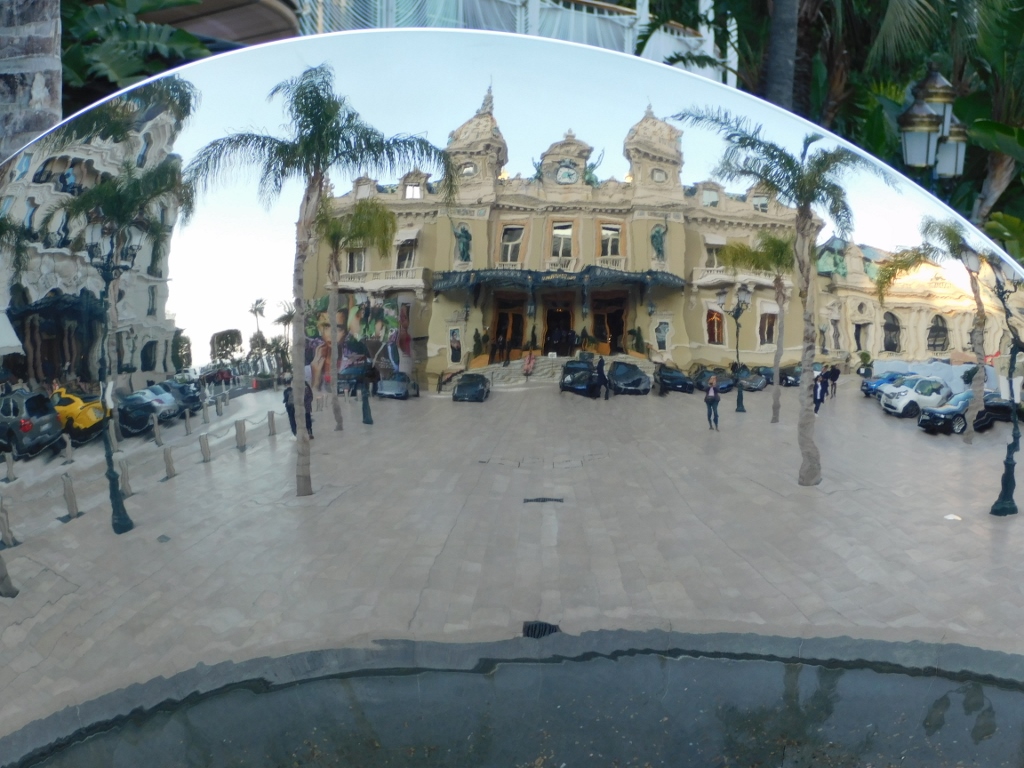 My opinion about the Monte Carlo Casino
My opinion about the Monte Carlo Casino
Joking aside, the photo above was made while walking around the Place du Casino where I noticed a sculpture in the shape of a concave-convex mirror.
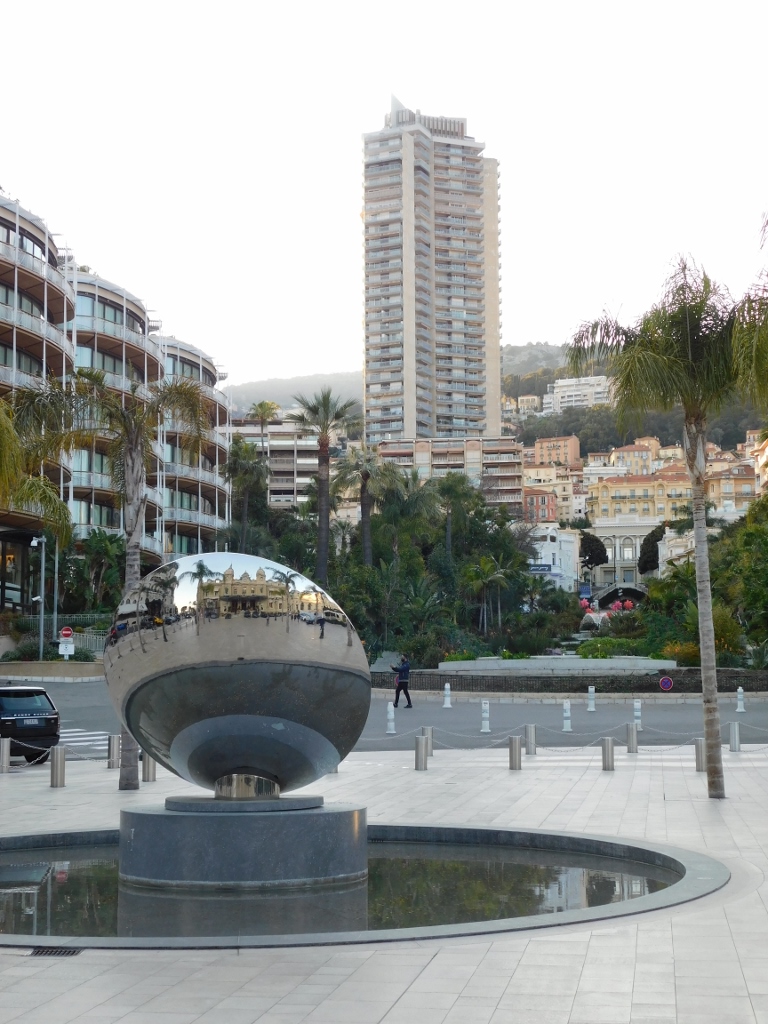 The convex side of the mirror in front of the Casino
The convex side of the mirror in front of the Casino
The square is also the place where a café-restaurant, Café de Paris, built at the beginning of the 20th century is situated. The café houses yet another casino.
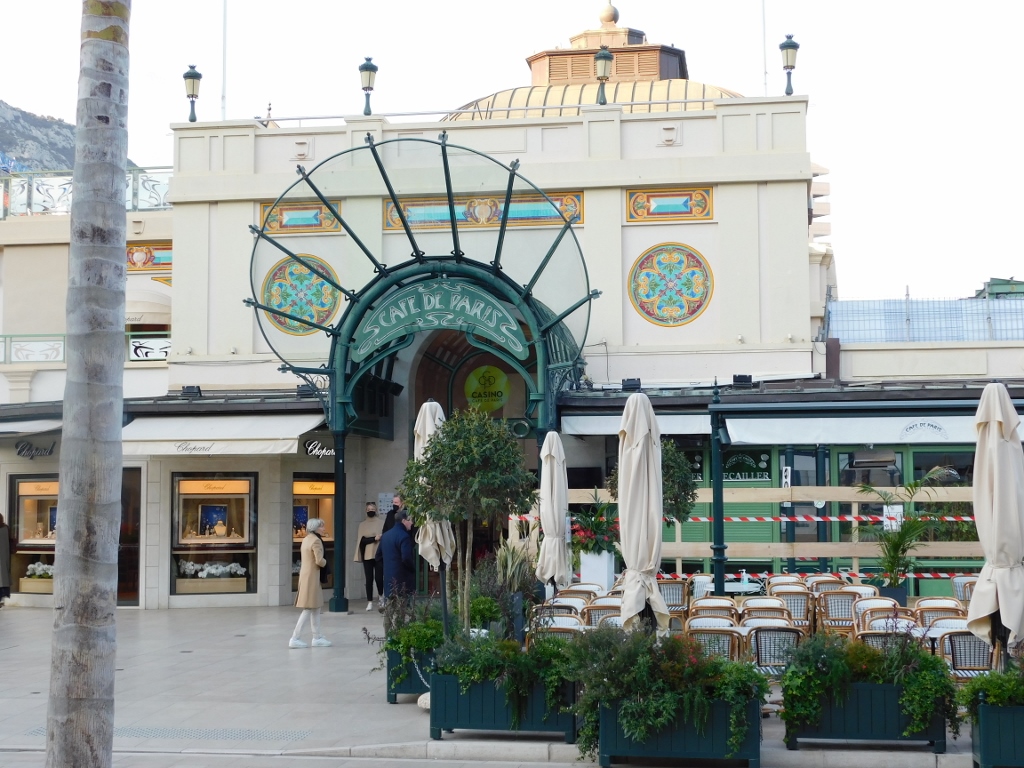 Café de Paris
Café de Paris
Instead of gambling, I moved on in order to be able to take a photo of the whole square.
 Place du Casino: Café de Paris is on the left and the Monte Carlo Casino is on the right
Place du Casino: Café de Paris is on the left and the Monte Carlo Casino is on the right
From here I continued to walk along an avenue simply because this was in the direction of the train station. As it turned out, this was one of the most exclusive and most expensive shopping streets in the world.
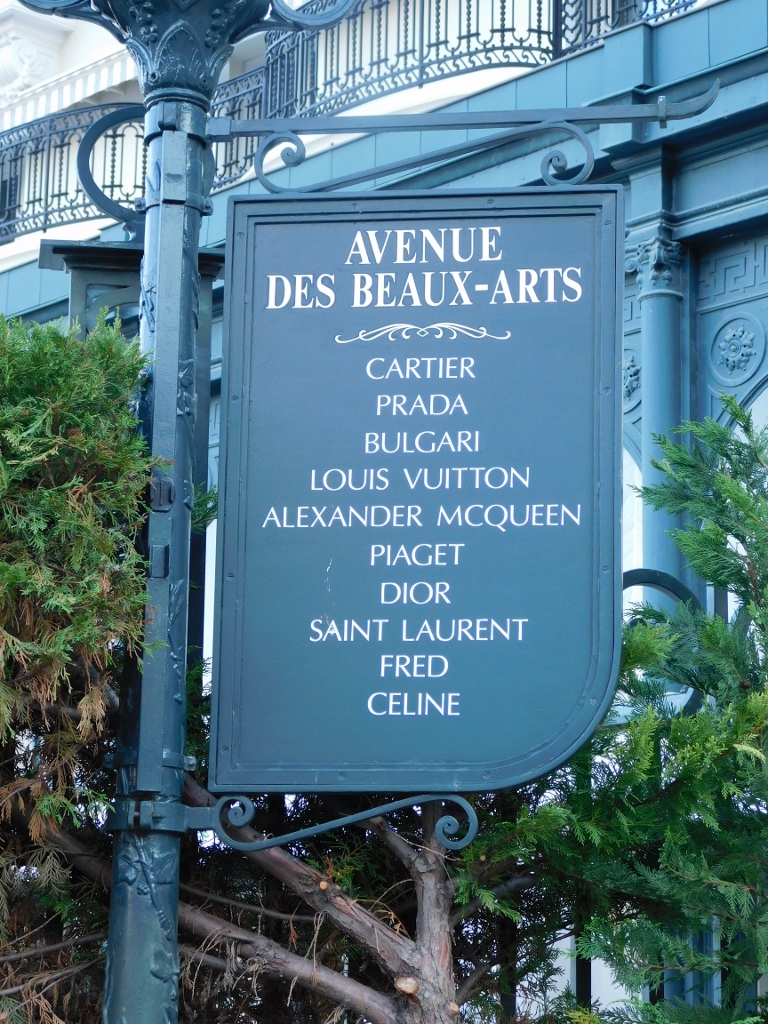 Monte Carlo, a detail
Monte Carlo, a detail
I found it interesting that in some internet maps I could see that only a dozen of years before this street was used by vehicles and a completely different building was on the right-hand side of the site seen in the following photo. Nowadays, or rather in 2022 it looked quite different and was obviously intended only for pedestrians.
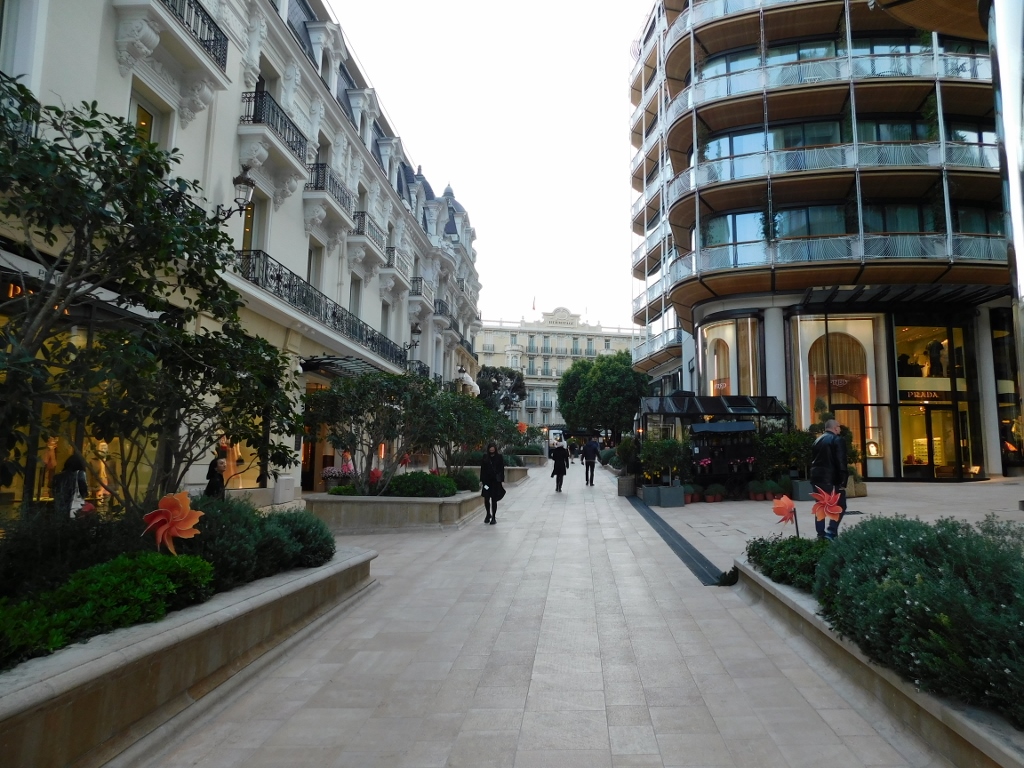 Monte Carlo, a detail
Monte Carlo, a detail
Not counting occasional pauses in order to take some more photos, I continued towards the train station. The train arrived soon enough and less than half an hour later I was back in Nice. I was very tired, but also very content with this day. I saw all kinds of places and in my opinion I visited the part of the French Riviera east of Nice quite nicely.
But, I also had to get a good rest, since I planned to visit very different places on the following day.